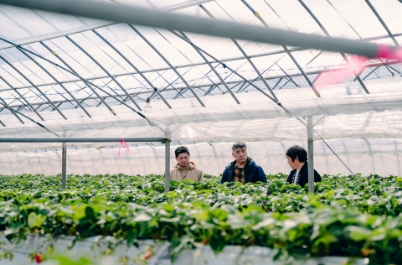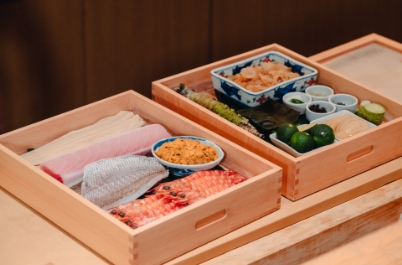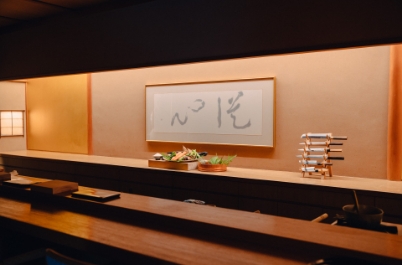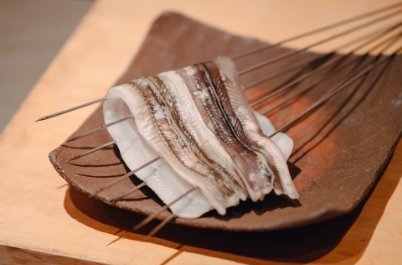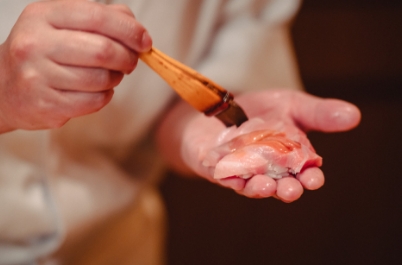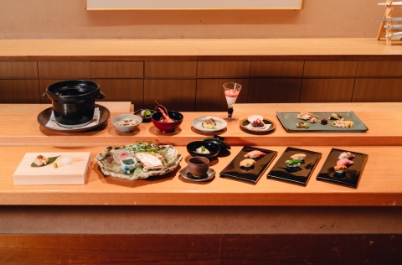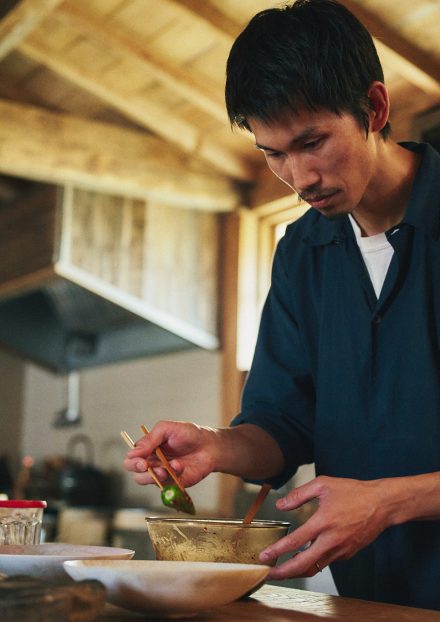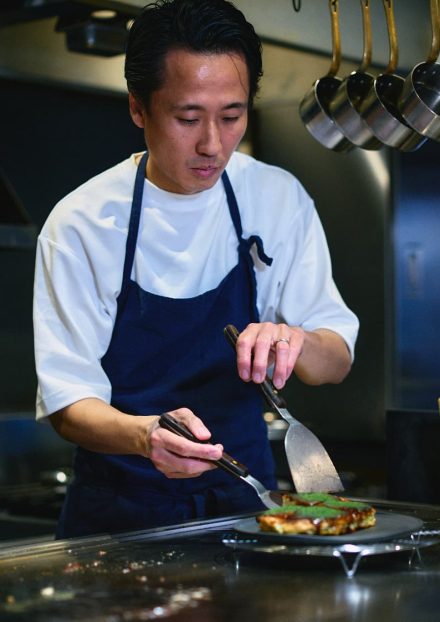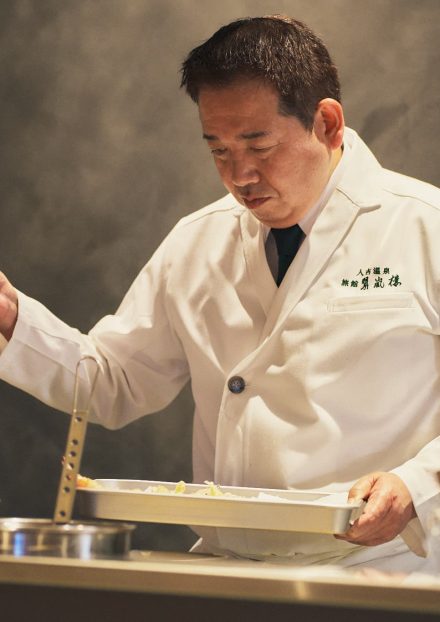Japanese Restaurant Benkei/Sushi Restaurant Tachibana
Mikio Nakajima/Norio Ono
Prolougue
Story 1 A caring hotel that blends in with the Kumamoto landscape
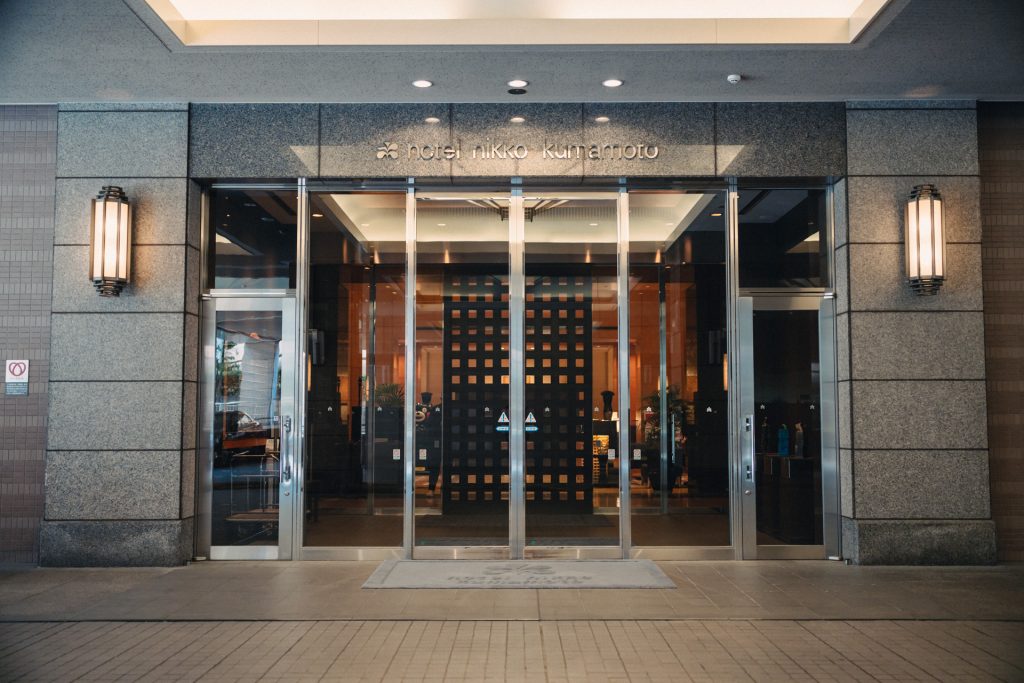
In the commercial center of Kumamoto is a place called Machi. A trolley heads toward Kumamoto Castle, and arcades line each side of the street. Torimachisuji Street, which bustles with people, is one of the representative scenes of Kumamoto. Since its opening in 2002, Hotel Nikko Kumamoto, which perfectly blends in with Kumamoto’s landscape, has been the home of two Premium Chefs.
“Blending in” does not just mean that the building has become part of the landscape. It means that Hotel Nikko Kumamoto has become a beloved part of Kumamoto. This would not be possible if the hotel was simply standing there.
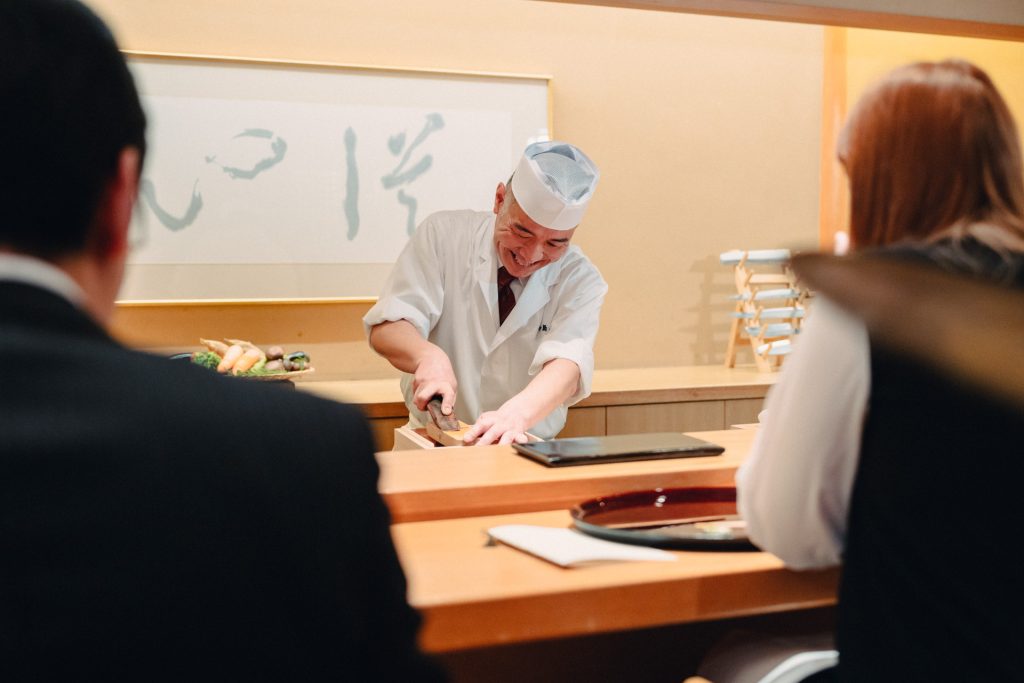
“Our philosophy is to strive to communicate the hotel’s culture and contribute to the local community, as well as to continue evolving into an even more wonderful hotel that is loved by its guests,” Says Mikio Nakajima, head chef of the Japanese restaurant Benkei. This attitude is linked to the way the hotel cares for everyone involved, and the hotel treasures the beautiful spirit that has been passed down in Japan.
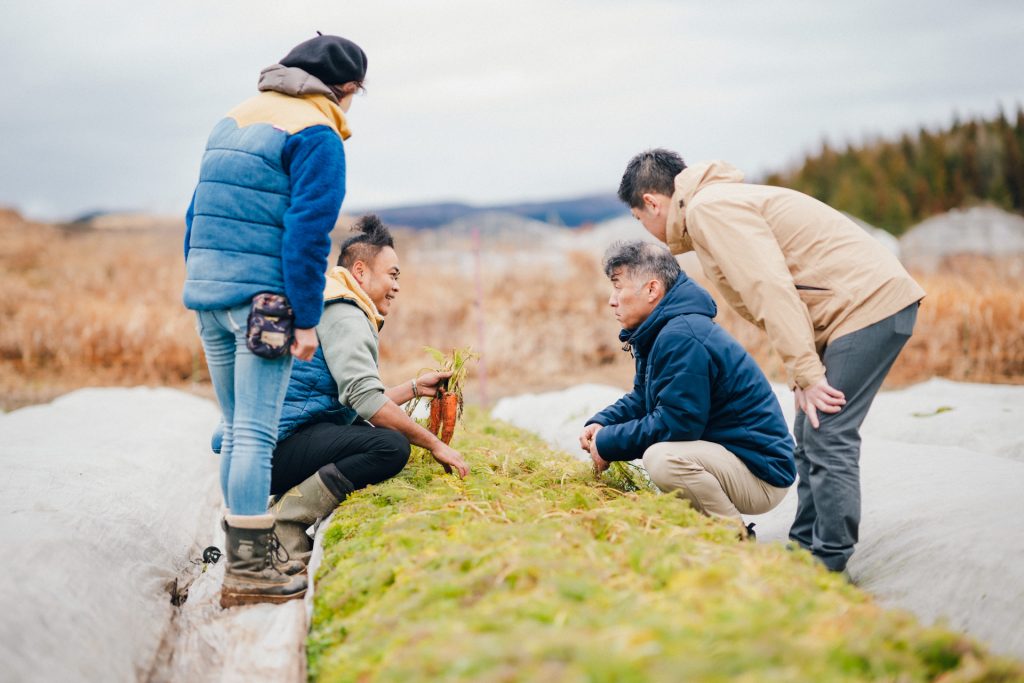
One initiative was the 2022 establishment of the Yamato Farm, which focuses on organic farming in Yamato Town. It started as the chef’s initiative. “I wanted to know more about Kumamoto’s local foods. I wanted to connect with the producers.” On his days off, he would trudge up to the fields and help with planting and harvesting. He put in sweat equity, and they would all eat rice from the same pot. This happened spontaneously.
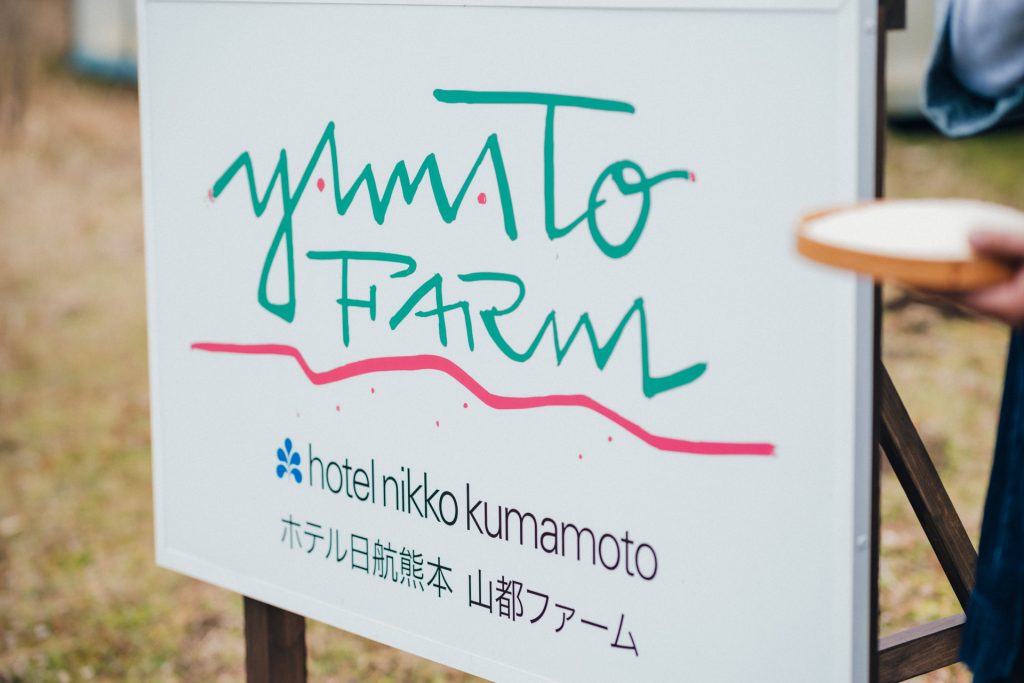
He has also deepened his relationships with the community as a chef by holding food education events.
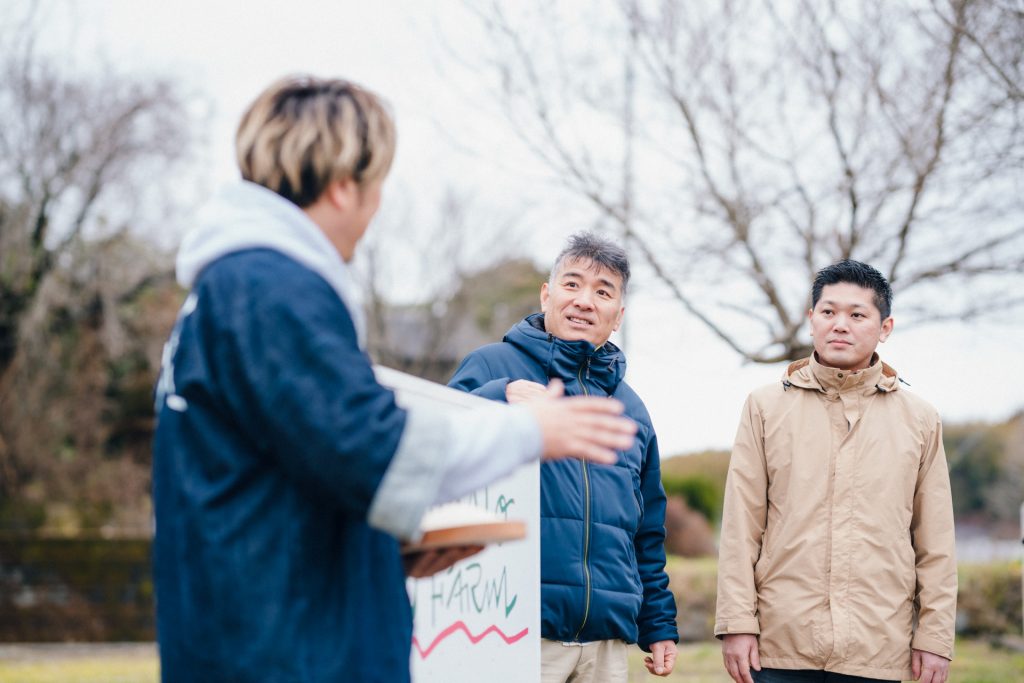
He not only looks for local vegetables but also procures Amakusa seafood, Amakusa black beef and red beef, and Matsuai miso and soy sauce from Shiranuhi Town. He is seeking original creations that can only be made at Hotel Nikko Kumamoto, which is a reflection of Kumamoto’s ambiance. That is how he got to know Kumamoto.
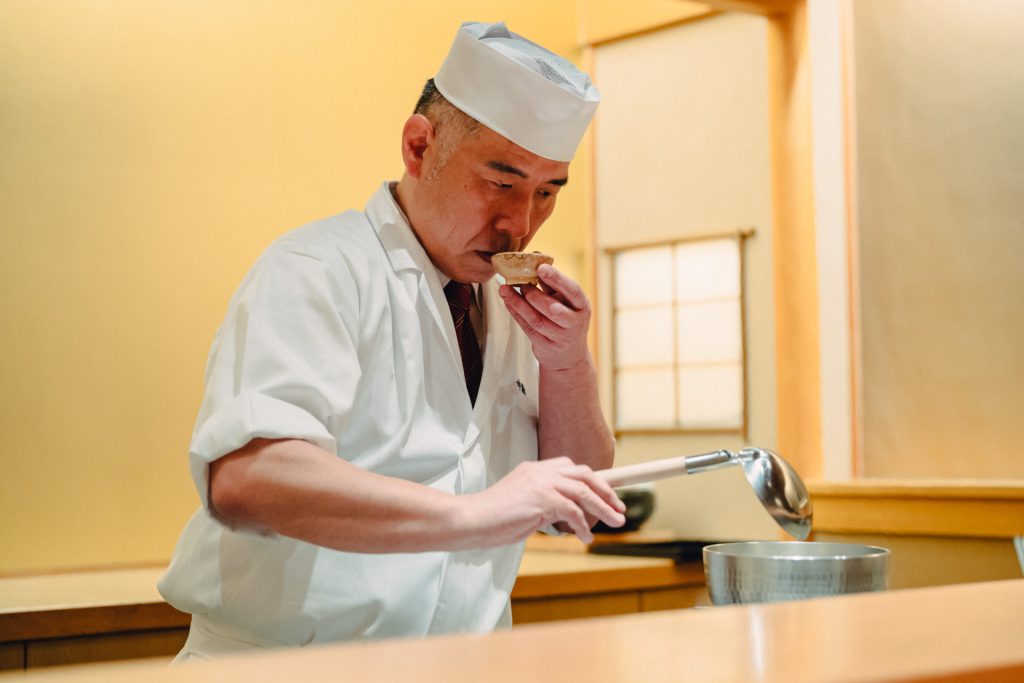
Chef Nakajima of Japanese Restaurant Benkei is originally from Kyoto. He earned his chops at Hotel Nikko Osaka and went to Benkei in 2002. This was the first time he visited the Kumamoto area. He says that, at first, he was using ingredients from throughout Japan, as he had been doing before, but he gradually shifted to ingredients produced in Kumamoto Prefecture.
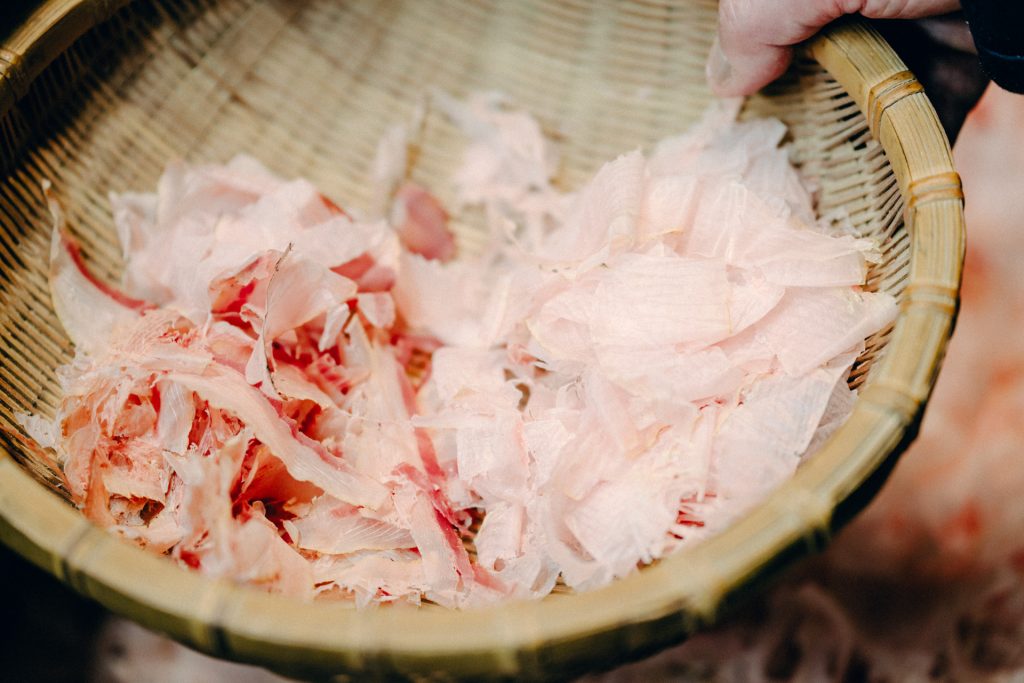
“For all of these wonderful ingredients, Shogyo Murahei has been of vital assistance to Benkei since it opened. Soup stock is a mainstay of Japanese cuisine, so if it came to a situation where Shogyo Murahei could not supply us, then I don’t think we could keep the restaurant open.” There’s a major reason why he likes them so much, but that will be discussed later.
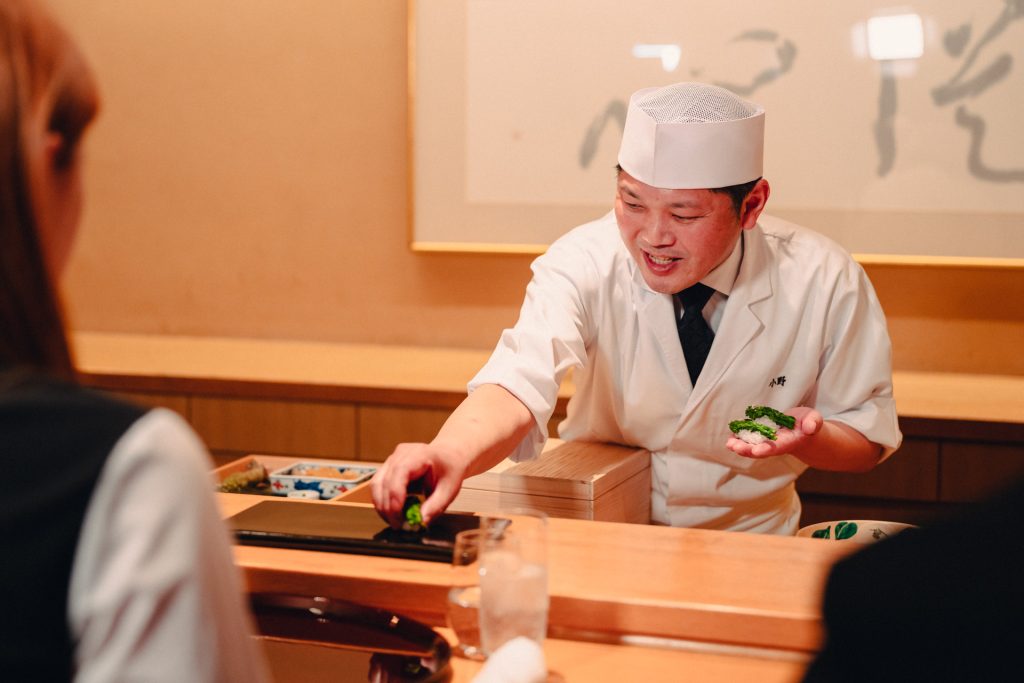
Let us get acquainted with another Premium Chef, sushi chef Norio Ono of Sushi Restaurant Tachibana. He grew up in Ushibuka Town in Kumamoto. He trained at Kyoto and Kumamoto and has been with Tachibana since 2006. As a sushi chef, he works behind the counter and fascinates customers with his elegant movements.
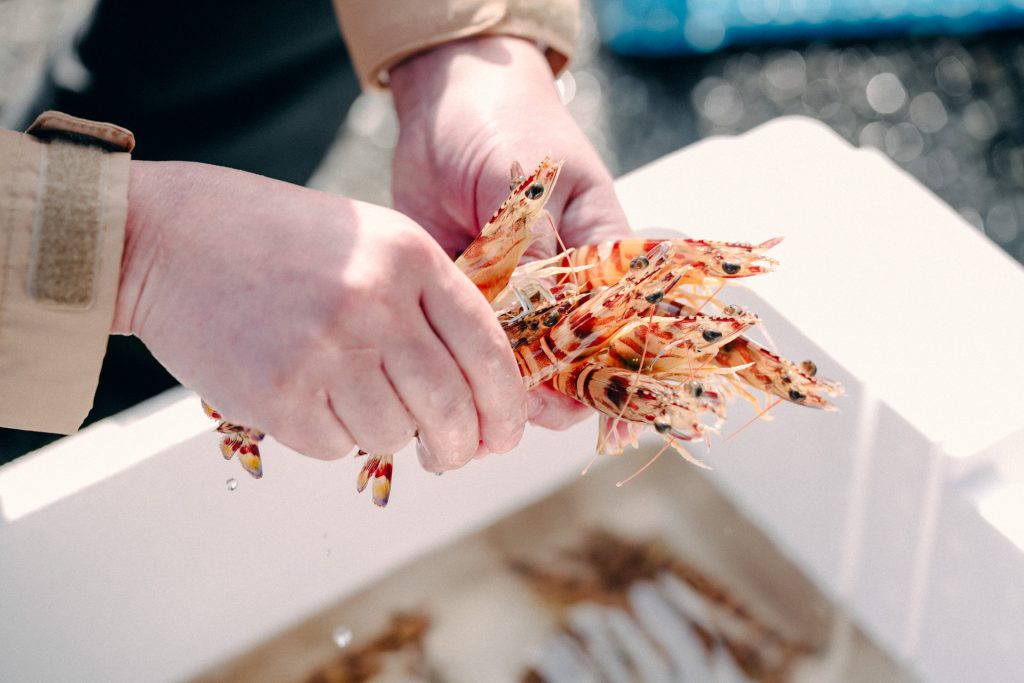
“I found out how wonderful Amakusa’s fish is when I started learning about sushi. When I was making sushi at the counter, customers would remark on how delicious the fish was and ask where it was from. I was happy to respond that the fish was from Amakusa,” he says with a grin that shows he is proud of his origins.
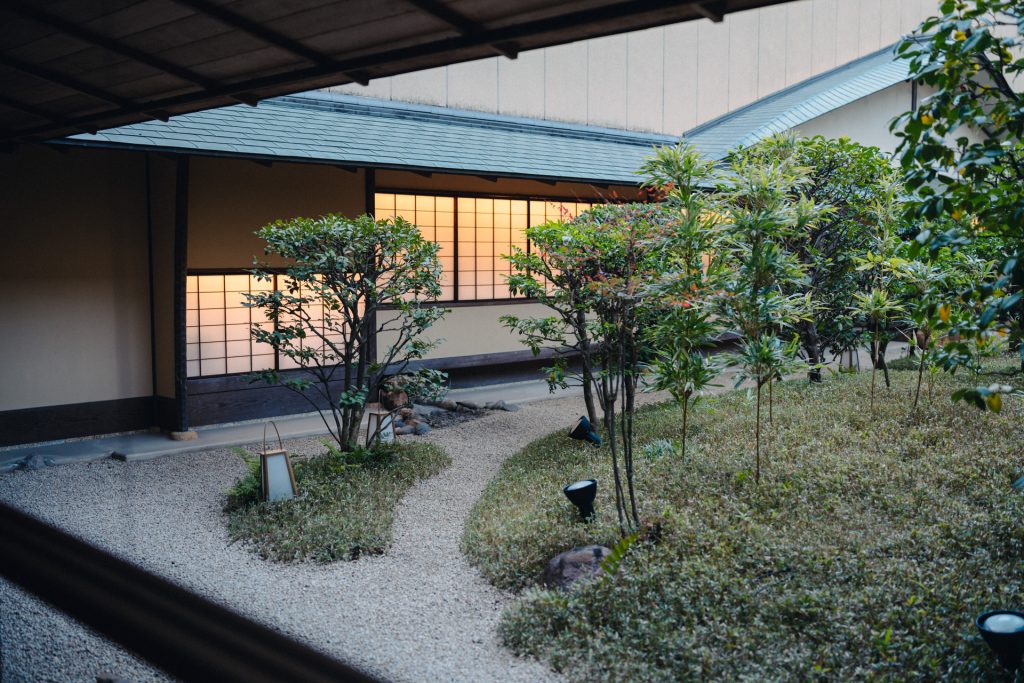
Why are there two chefs here? The reason is that both of them decided they wanted to provide the ultimate in hospitality to the guests at Hotel Nikko Kumamoto by offering a banquet of kaiseki cuisine and sushi. Among Japanese food, sushi has a unique existence so that it can be considered a separate category. The two chefs usually work in different kitchens, but they have teamed up for this occasion.
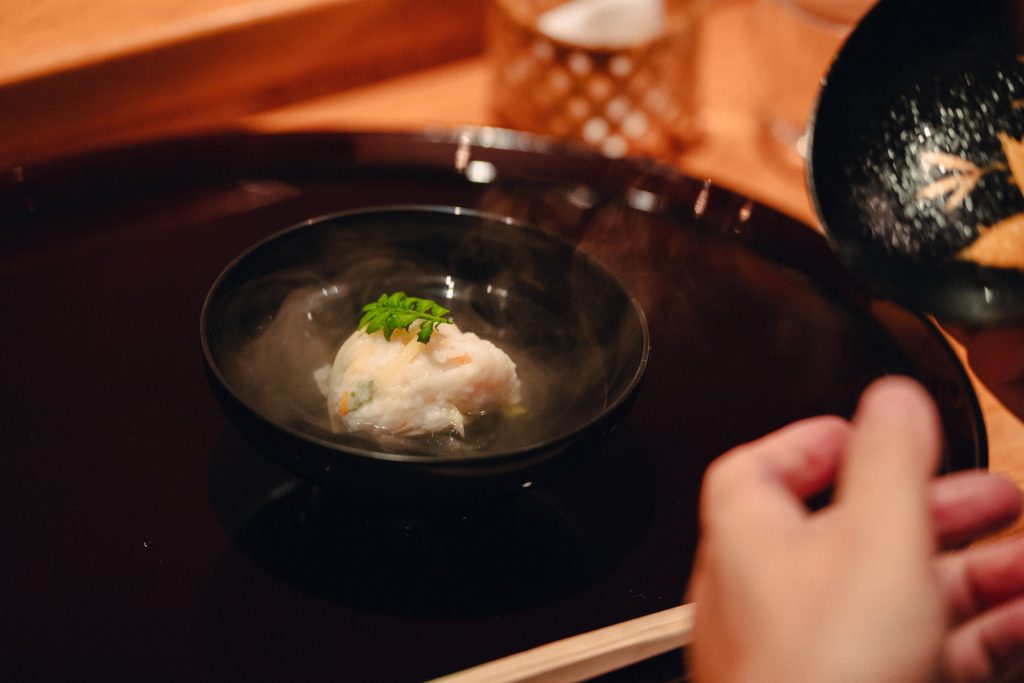
What kind of Premium Menu will they offer? Will the sushi be served last? No, the two chefs will not provide that kind of service.
This will be the pinnacle of Japanese gastronomy, an entertaining fusion of kaiseki and sushi.
Story 2 “Tsumugu” time, created by kaiseki and sushi professionals
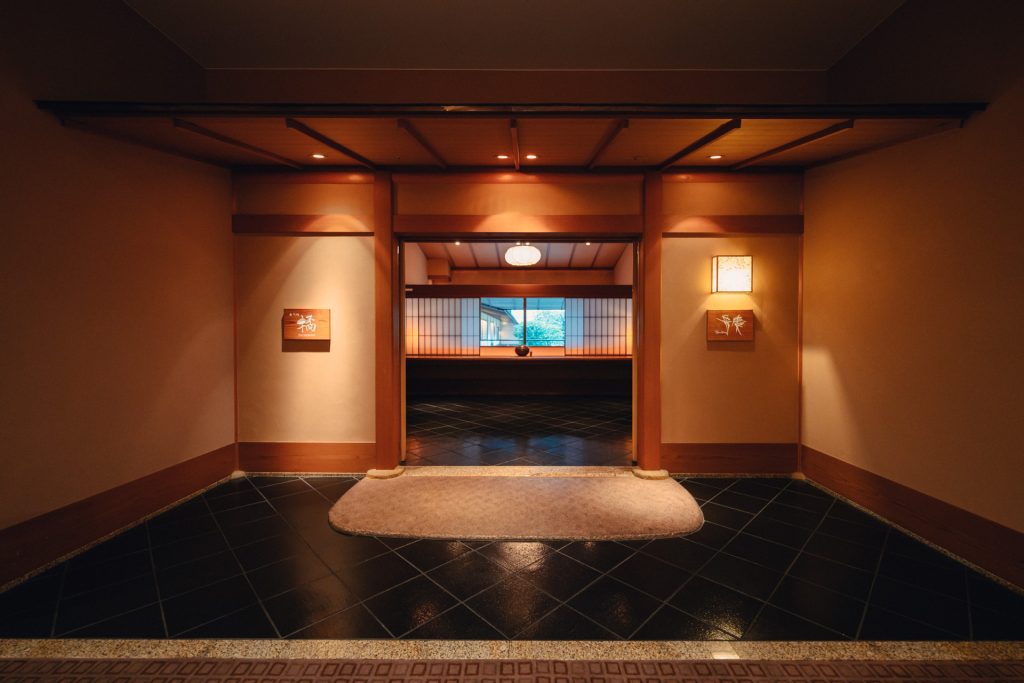
The stage chosen for guests to spend time enjoying the Benkei and Tachibana Tsumugu Premium Menu is the restaurant Kozue, which is just a counter inside Benkei.
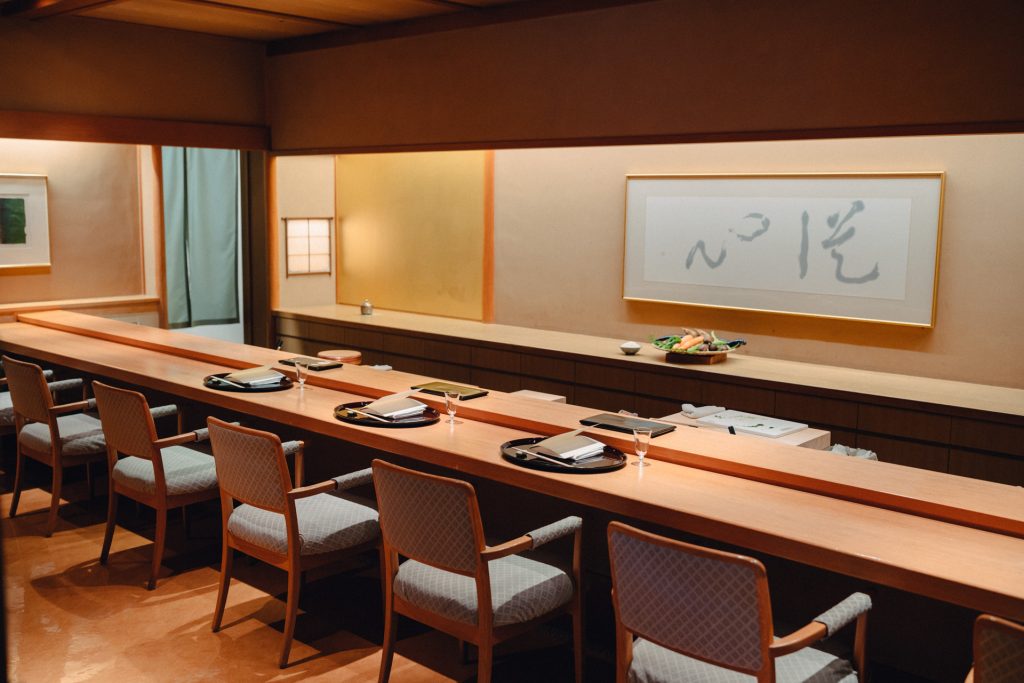
Guests can watch the chef working on the other side of the counter a step lower than their seats. “Showing” the guest here means “entrancing” them. Nothing in the preparation area is extraneous. Everything has been taken into consideration.
It doesn’t take long to realize that this dignified space is special.
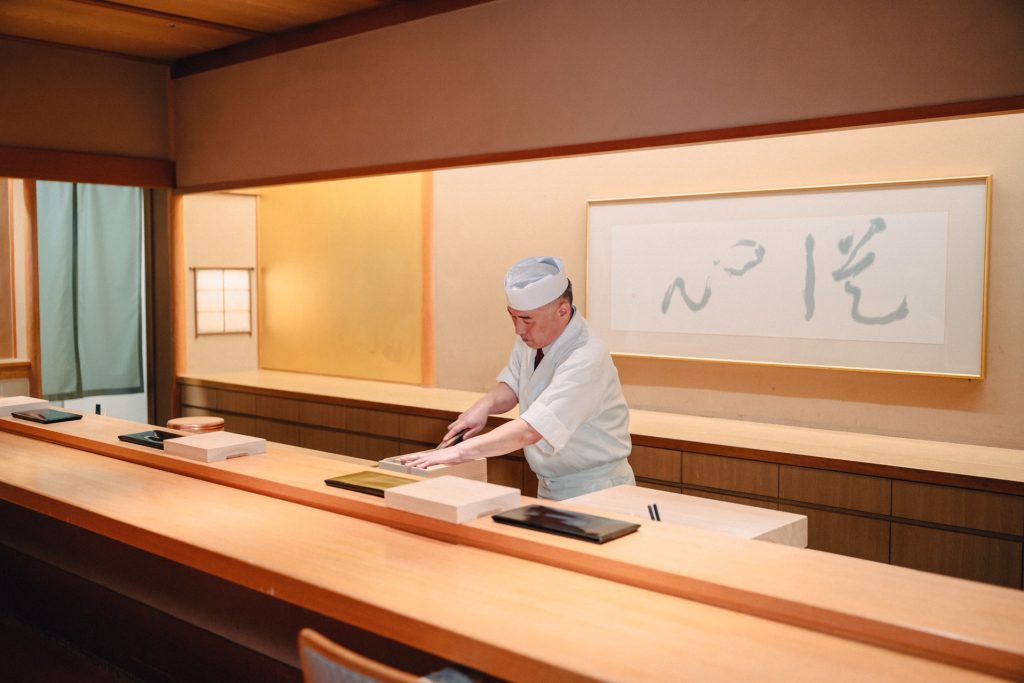
By the time it takes to open the door, take their seat, then close the door, guests realize that they have both the space and the two chefs to themselves.
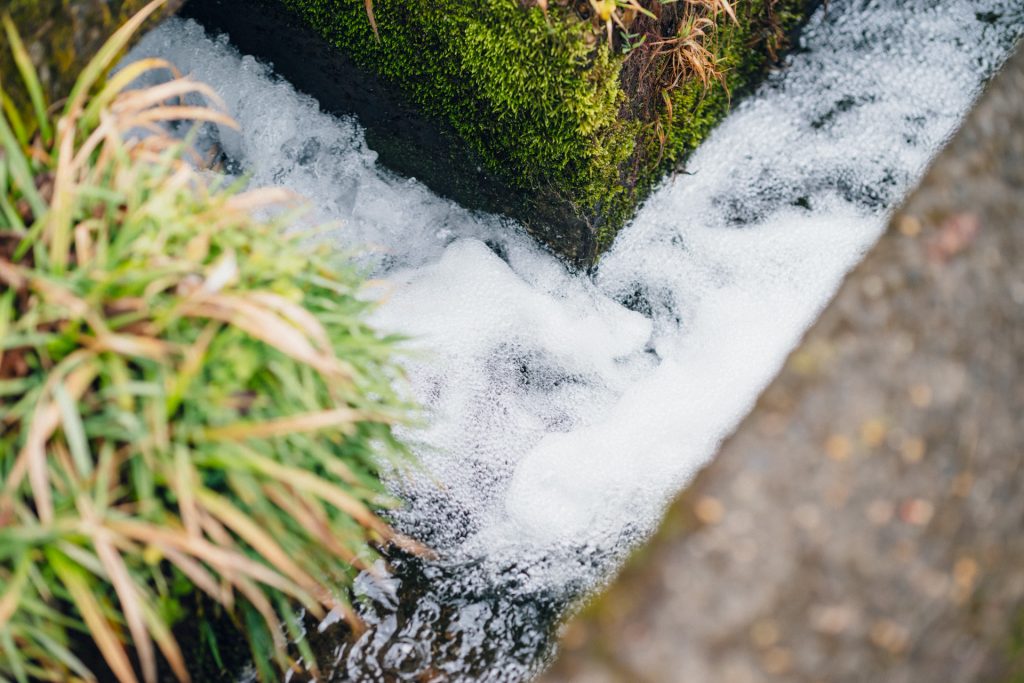
They chose “water” as their theme. More than 20 years have passed since the restaurants opened, and water signifies a renowned hotel with a century of history in the metropolis of Kumamoto. The pure water flows from the mountains to the sea. Vegetables grow in the mountains, and seafood comes from the sea. The land that this water fertilizes yields even more bounty.
“We cherish each and every thing that we encounter. We hope everyone will enjoy the “Tsumugu” Premium Menu at Benkei and Tachibana,” says Chef Nakajima.
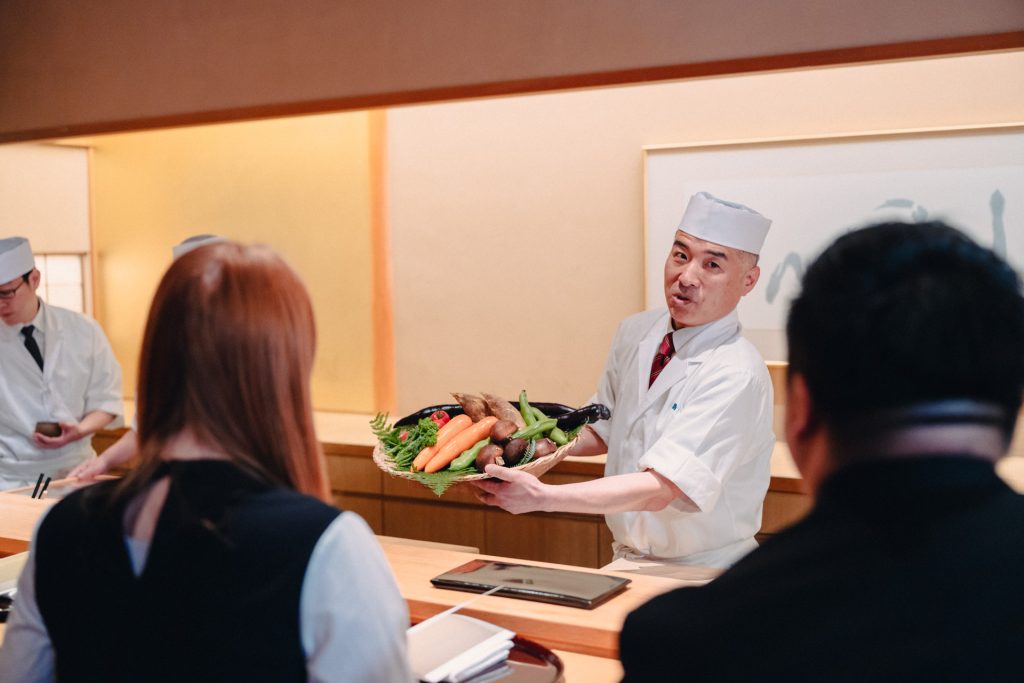
”Tsumugu” consists of four “chapters.”
The soup stock, which we previously said is essential to Japanese cuisine, is an important theme.
Introduction: Vegetables
The first course is a vegetable broth made from the ends of carrots, turnips, and shiitake mushrooms. Adding just a sprinkle of salt brings out the fragrance of the carrots so that one feels the power of the vegetables.
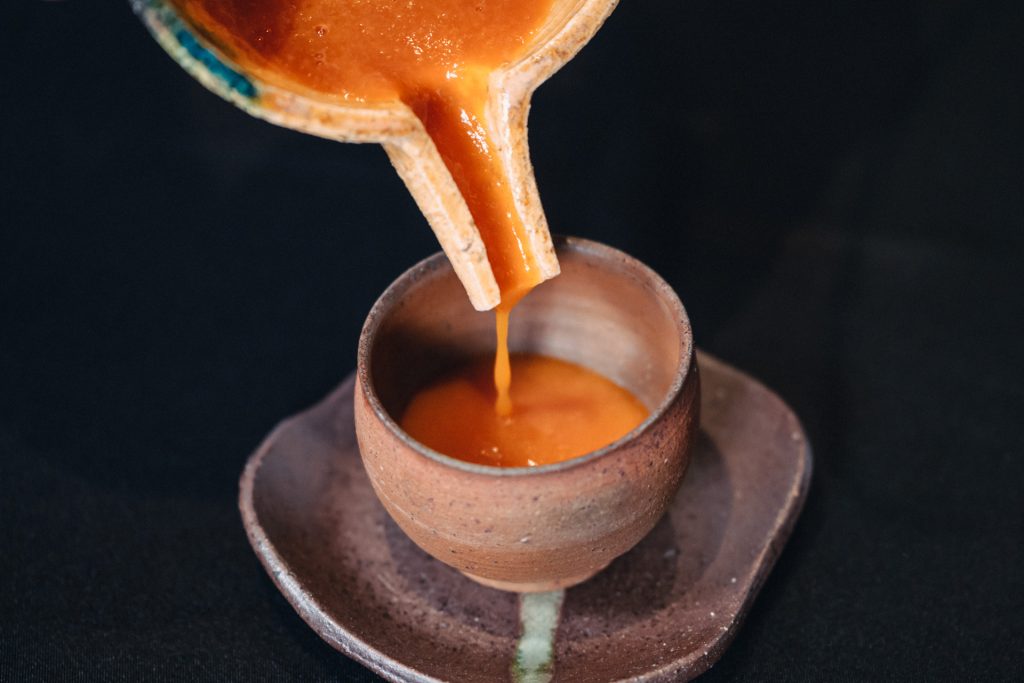
Yamato Town has a group called “Only in Yamato,” which is made up of farmers, chefs, and others responsible for the next generation. They focus on “things that can only be done in Yamato,” communicating their attractiveness to create a future that local children will want to work in and live in.
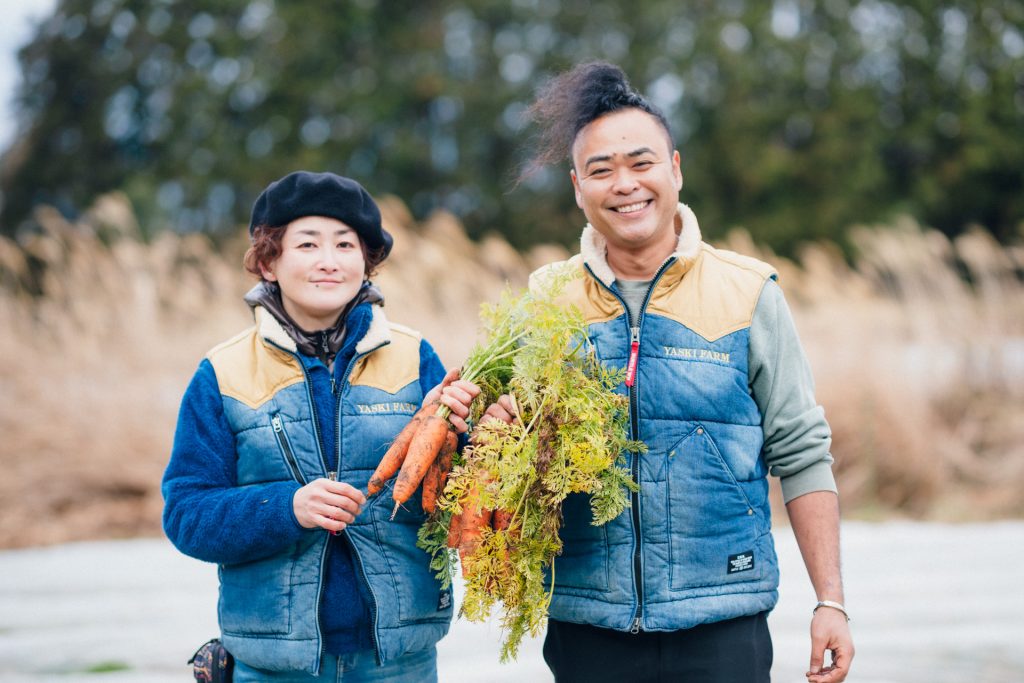
One of the group’s members, Yasuki Torigoe of Yaski Farm, moved to Kumamoto to grow organic vegetables. He believes in carefully preparing the soil and in the power of vegetables.
That is why his healthy carrots produce such a delicious broth.
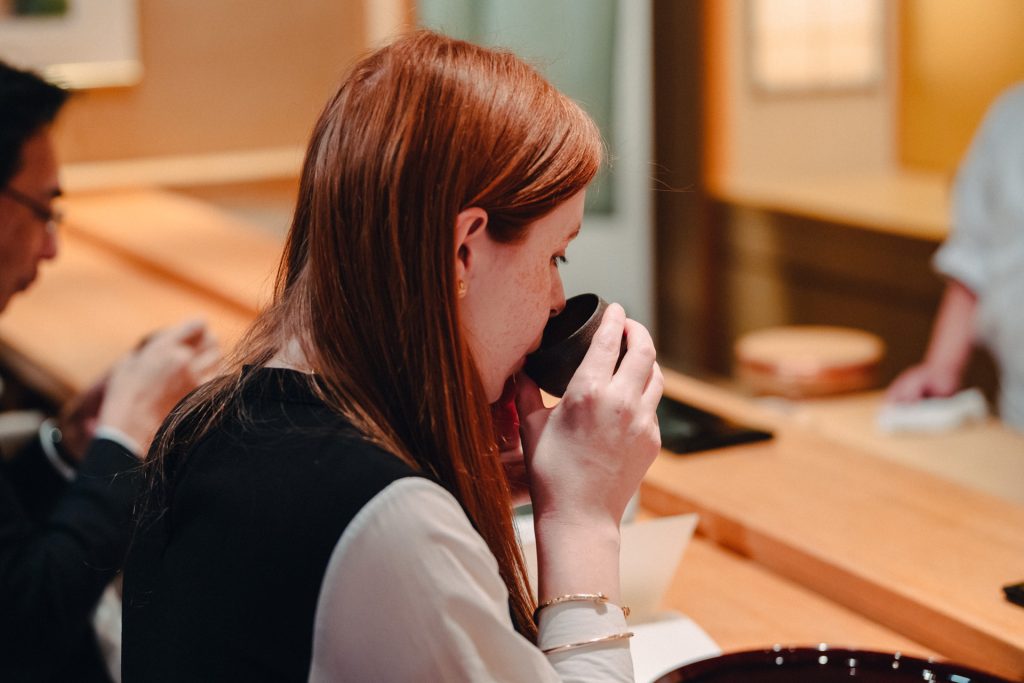
While savoring the sweet flavor of the carrots, a beautiful platter of appetizers appears in front of one’s eyes.
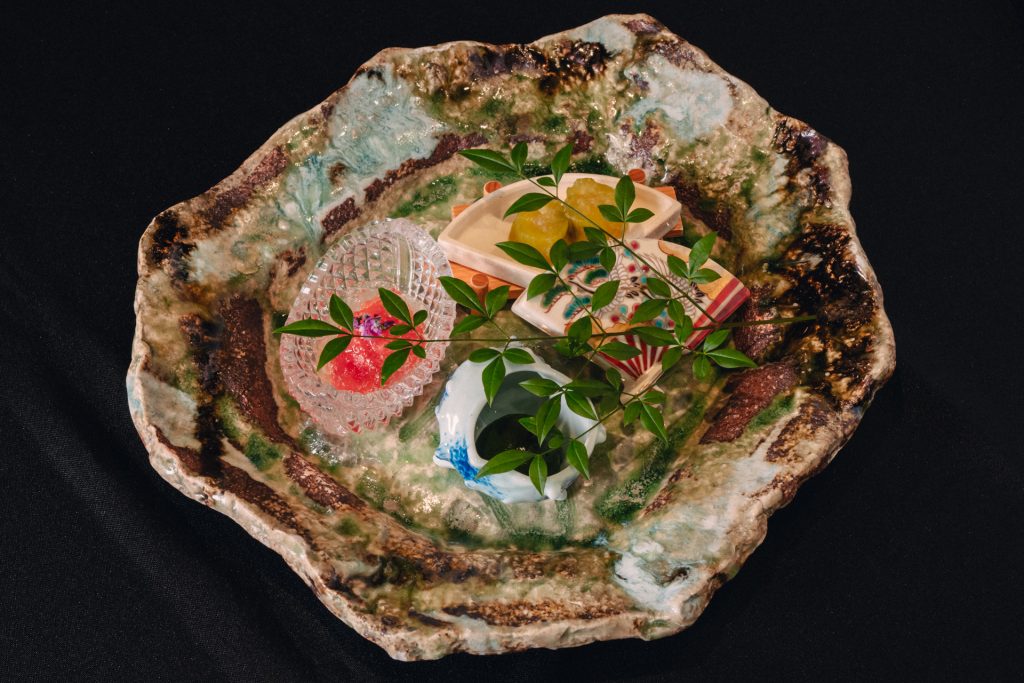
Before one’s eyes, at the end of the counter, Chef Ono makes pieces of “sushi” using bamboo shoots cooked in vegetable broth and warmed over charcoal and rapeseed blossoms soaked in kelp.
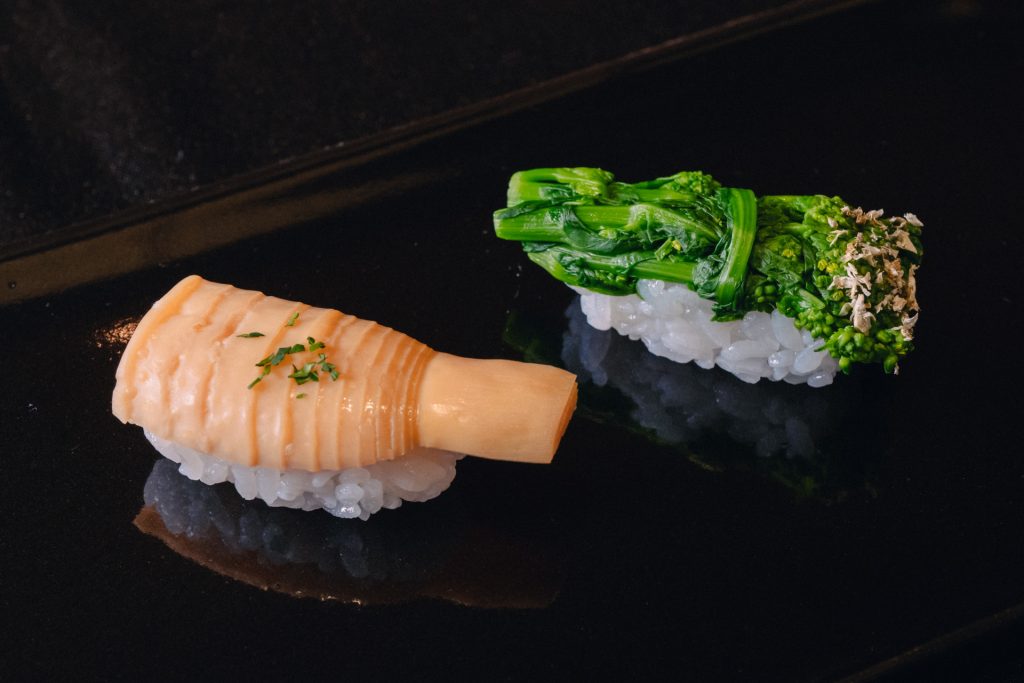
The rapeseed blossoms are decorated with shredded kelp. It’s eaten as is.
Next is Chapter 1: The sea. Making their appearance here are dried bonito shavings from Shogyo Murahei that Chef Nakajima is so fond of that Benkei would have to go out of business if he couldn’t get them.
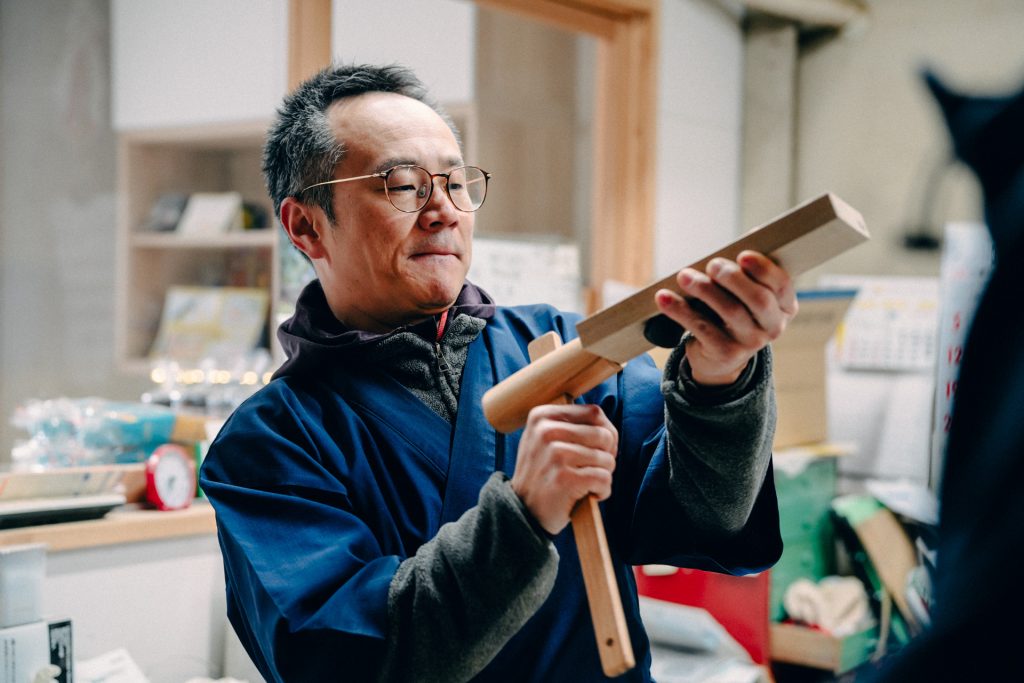
“We are particular about providing freshly shaved bonito every day,” says Shogyo Murahei’s representative, Seijiro Shimamura. They shave the dried fish every morning for delivery to their clients. They are so busy in the mornings that they can’t even answer the phone. This renowned store has been dealing in dried bonito shavings since its founding in 1953.
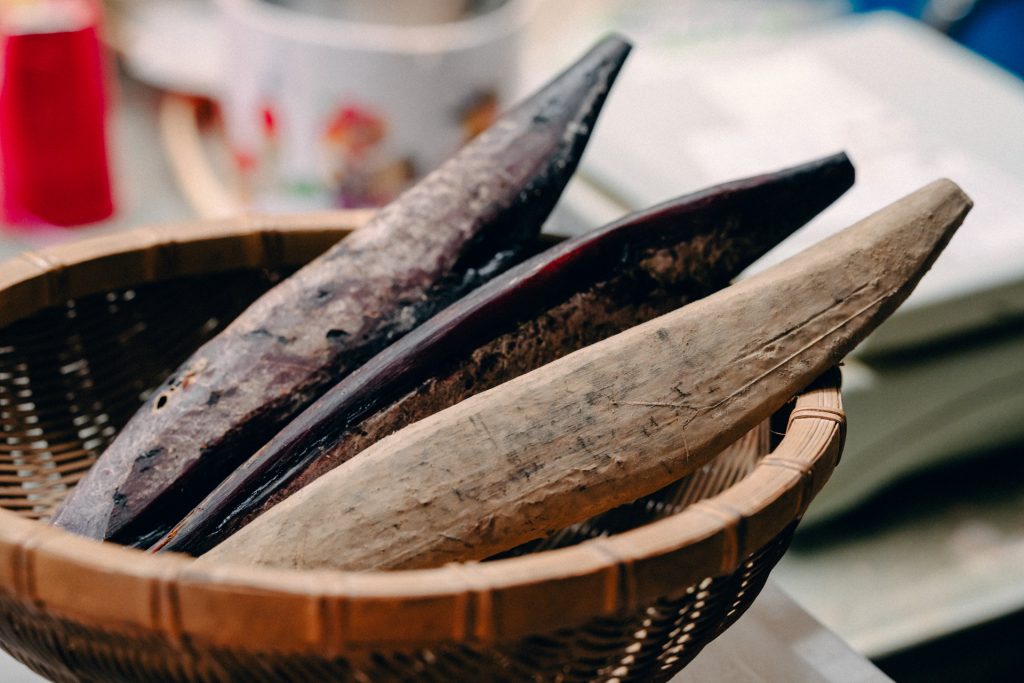
There is a procedure for making dried bonito shavings. The raw bonito is dried, which gradually enriches its flavor and enhances the aroma. Chef Nakajima comments that for the Premium Menu, he wanted guests to enjoy the flavor and aroma of the soup stock, so he procured pieces of dried bonito.
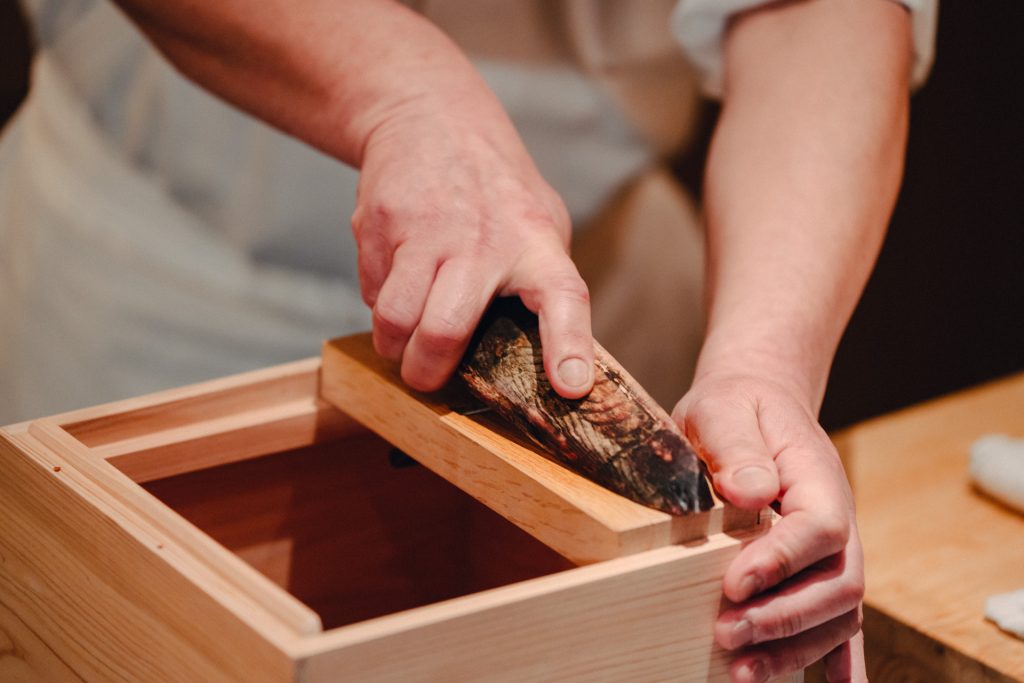
During the meal, he prepares soup stock using dried bonito that he shaves by hand in front of the guests. He likes this particular shaving box, which he ordered from Baumkuchen, which has a store in Tsuboi. Baumkuchen sells wood products, and the owners still operate their original forestry business.
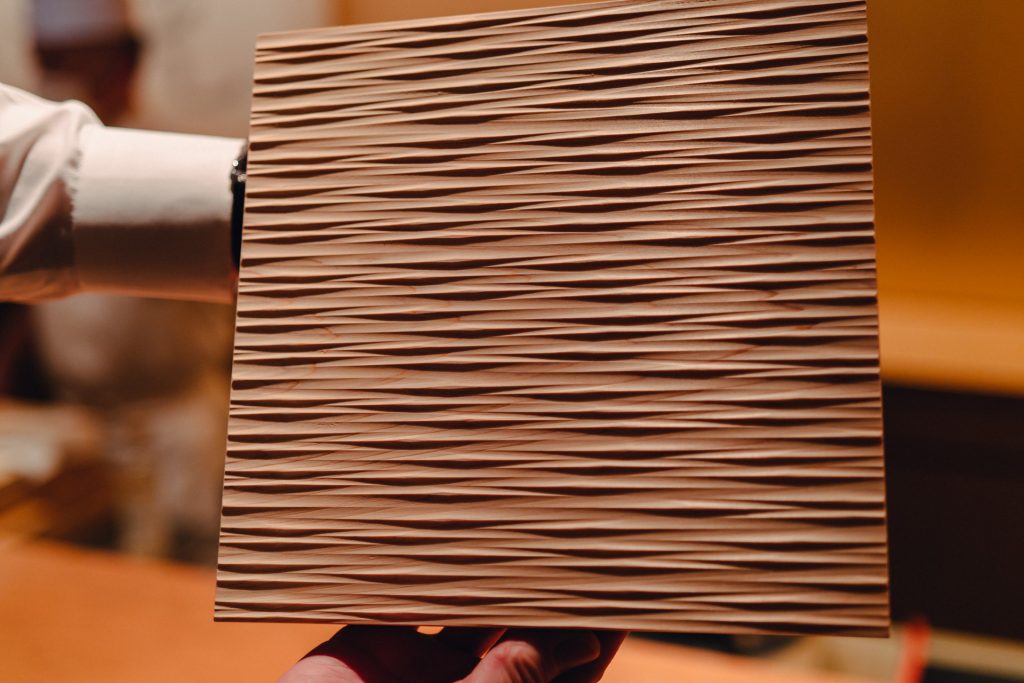
He says he also uses cutting boards and sashimi plates made of wood from Kumamoto.
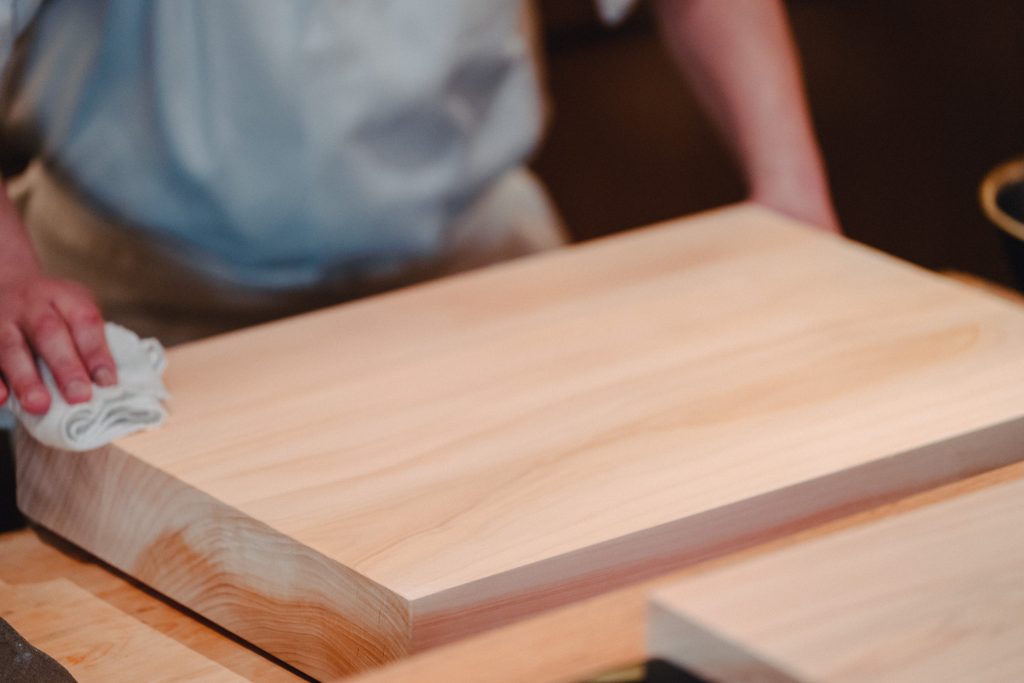
Returning to the discussion of soup stock, first taste the freshly made stock and savor the flavor and aroma of the dried bonito.
Next comes the simmered bowl.
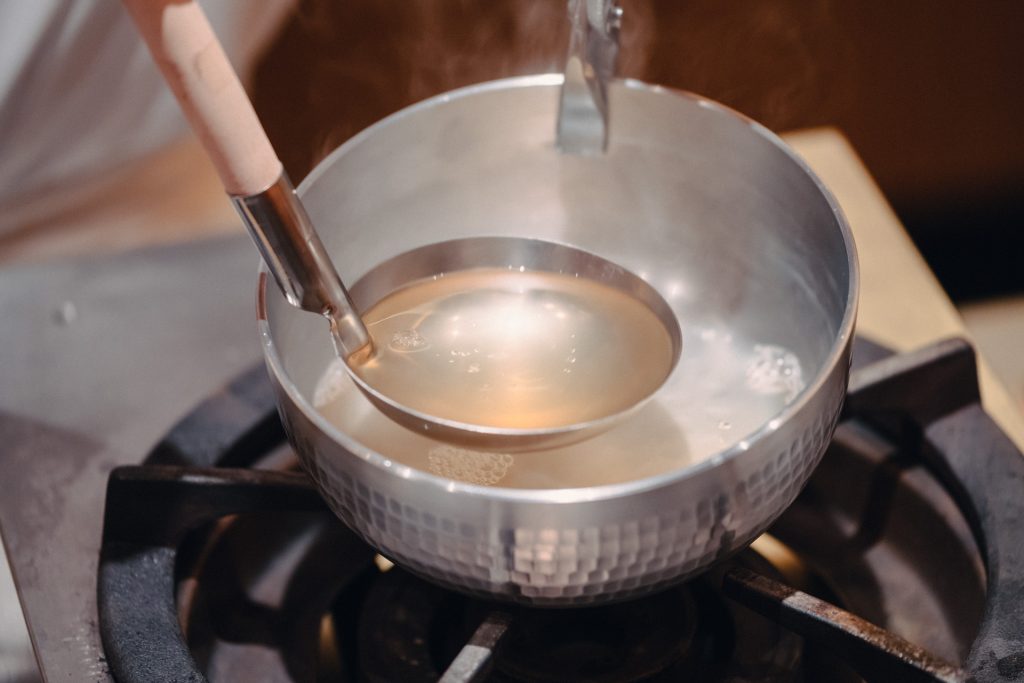
Dried bonito shavings are essential to the Japanese dinner table. It’s strange that when one hears this story, that the stock that they were casually sipping takes on a deeper flavor.
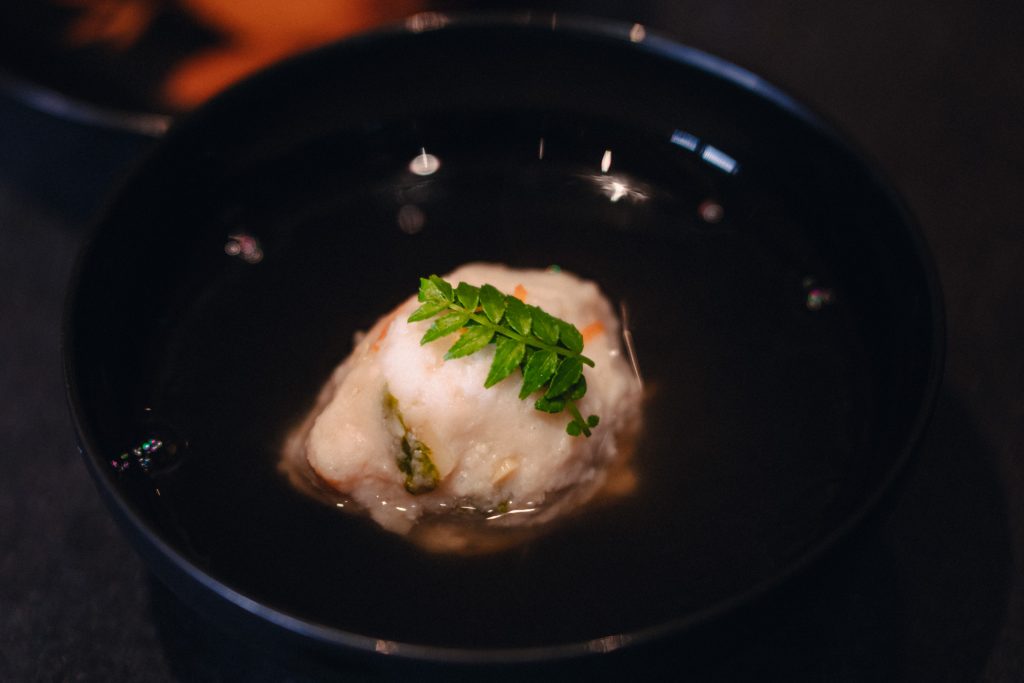
Next is sashimi.
Here comes spiny lobster marinated in sake lees from Yamato Town’s Tuzyun Brewery, which is a major player in the Kumamoto sake business. The lobster is sweet and firm, and it is excellent when paired with sake.
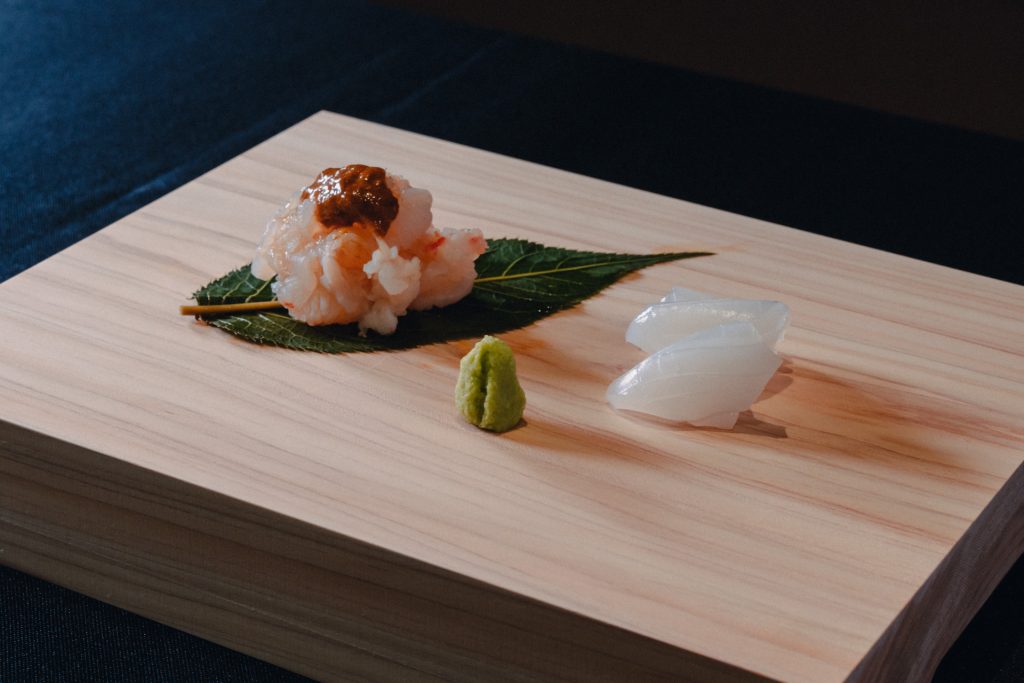
“The fish served today were all caught in Amakusa,” Chef Ono says. These include the famous spiny lobster, cuttlefish, small sea bream, tuna, sea urchin, and prawns from Miyagi Fisheries, which has been satisfying customers since its founding by giving them whatever they want.
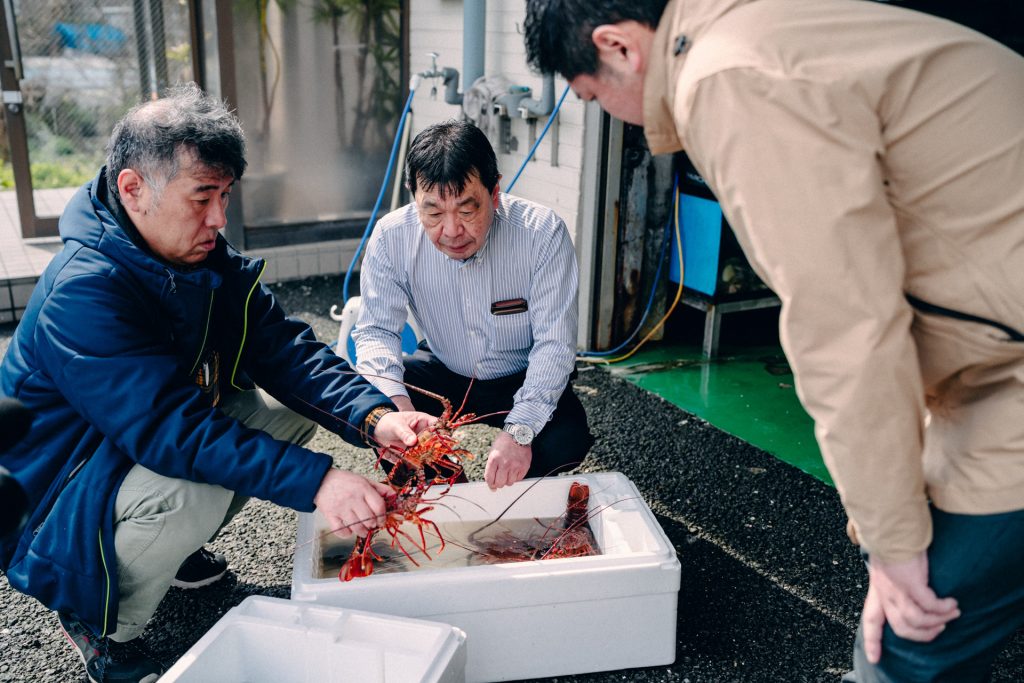
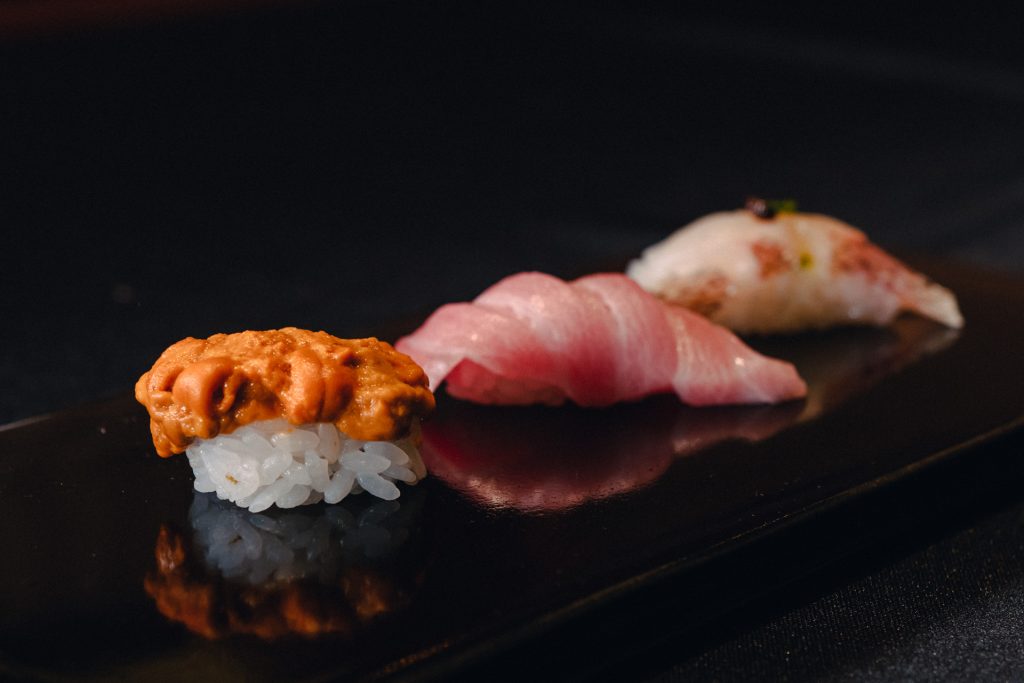
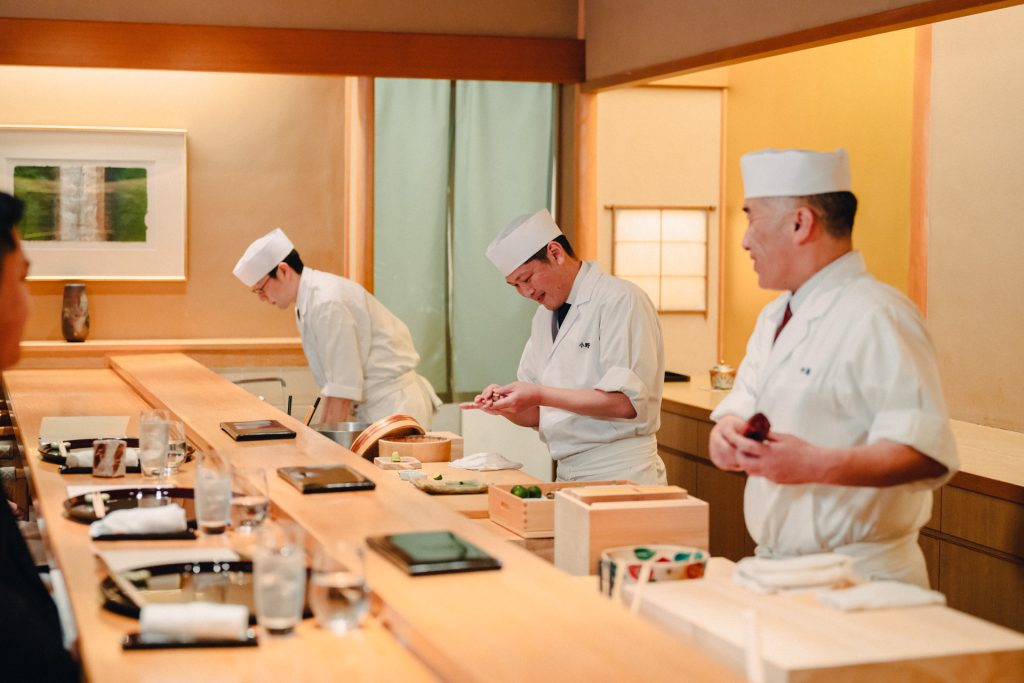
Dine while watching the beautiful work of the two chefs behind the counter and their harmonious collaboration. Enjoy watching, tasting, conversing. Japanese sake is of course essential.
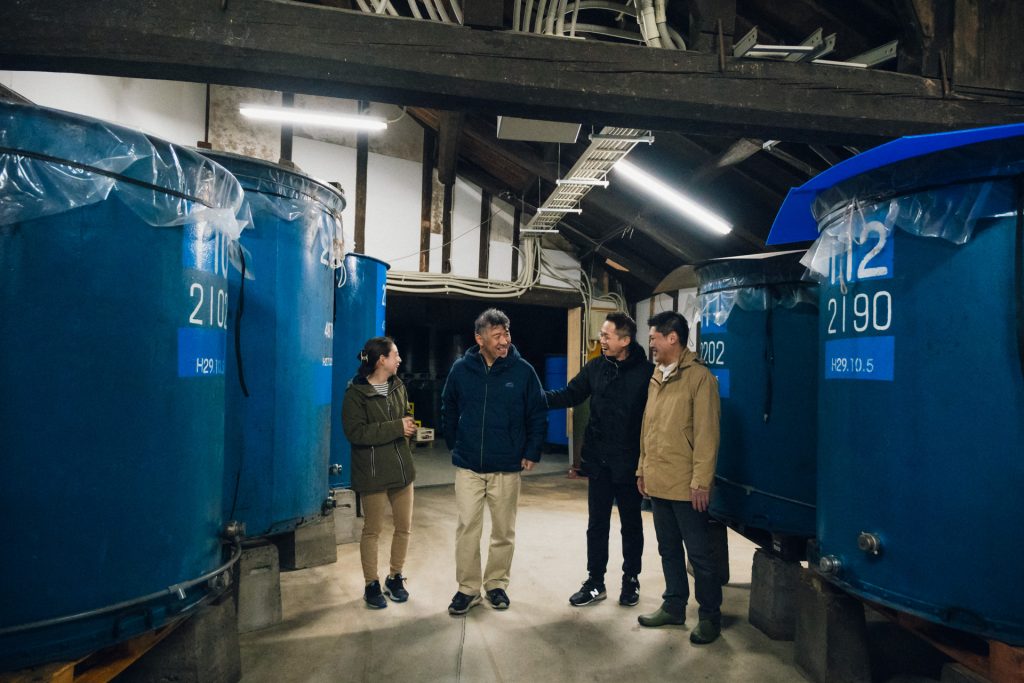
Tuzyun Brewery is a Japanese sake brewer in Yamato that also sells sake lees. This old establishment with a history of more than 250 years has been beloved by famous people. For example, the famous samurai Saigo Takamori once stayed there. It’s a place with harsh winters, which are optimal for sake making, and almost 100% of the brewer’s rice used there is grown in Yamato. Furthermore, all of this locally produced and locally consumed sake is made with Kumamoto yeast (Kyokai No. 9 yeast).
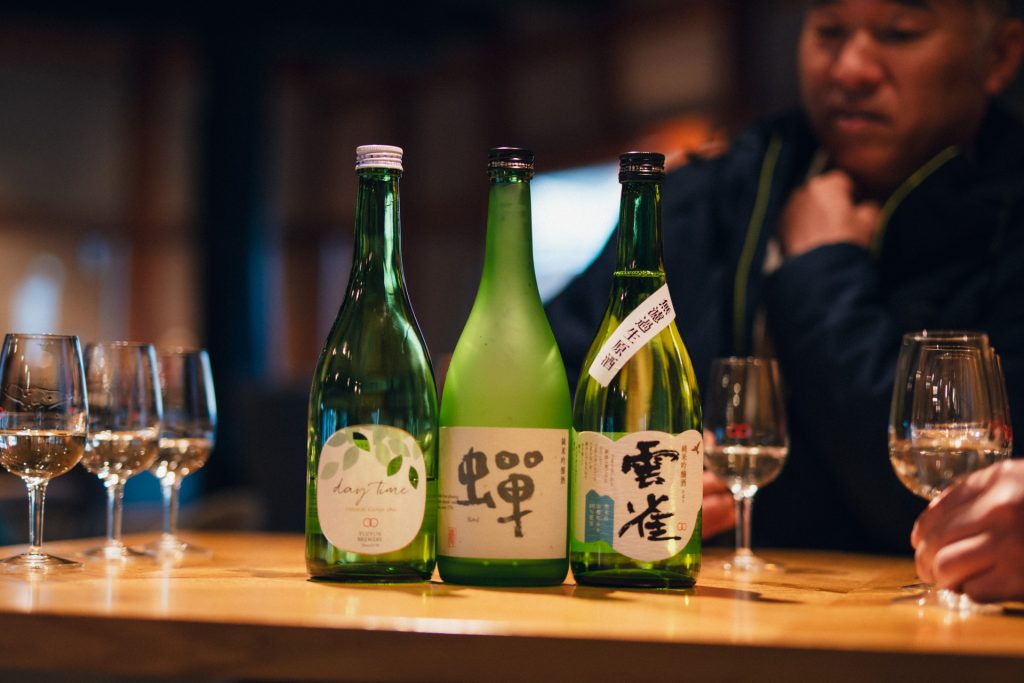
Please feel free to ask about the pairings of food and sake during the meal.
Chapter 2: The land. The eight-variety grilled dish, sushi, and charcoal-grilled items convey the power of Kumamoto’s land.
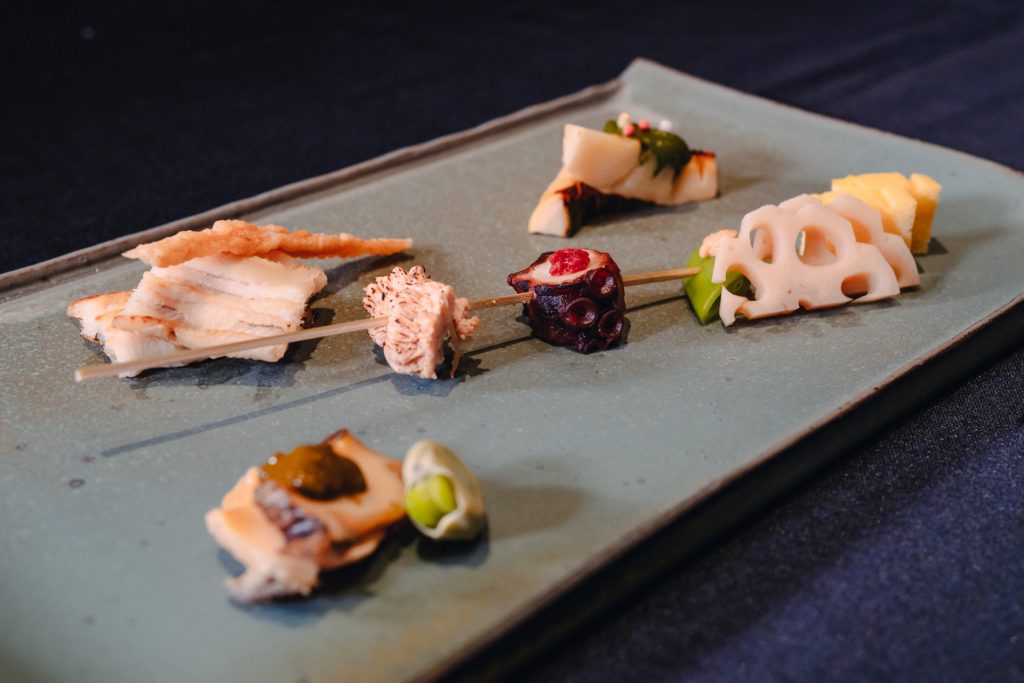
Here are the prawns that Mr. Haraguchi of Miyagi Fisheries talked about before. The red and white color is beautiful, and of course the taste is exquisite. He told us that farmed prawns usually have a better flavor and appearance than wild-caught prawns.
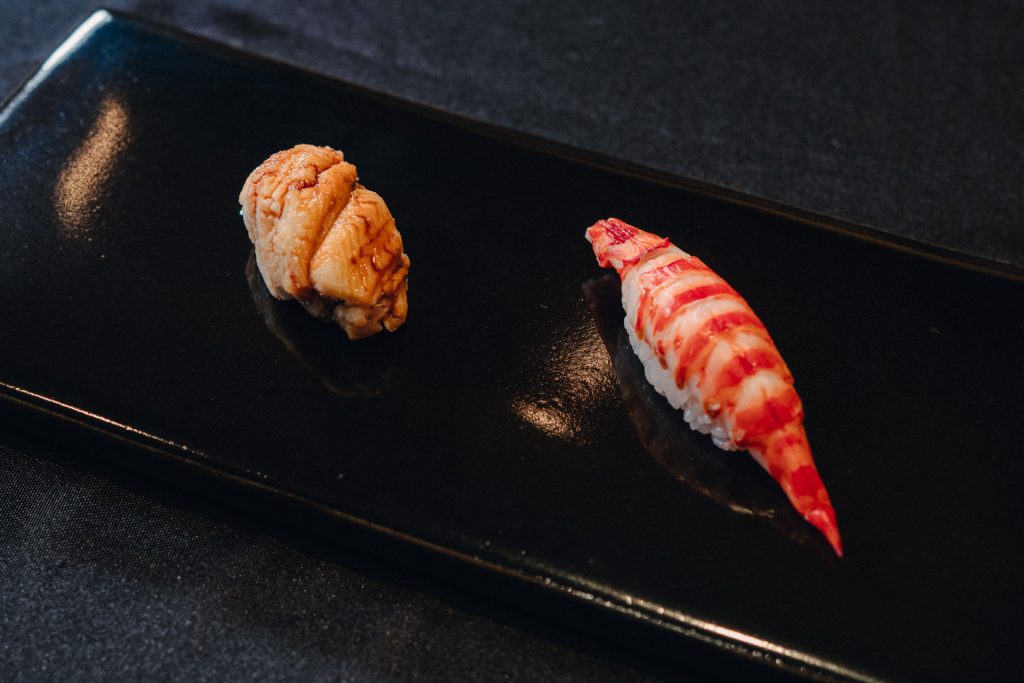
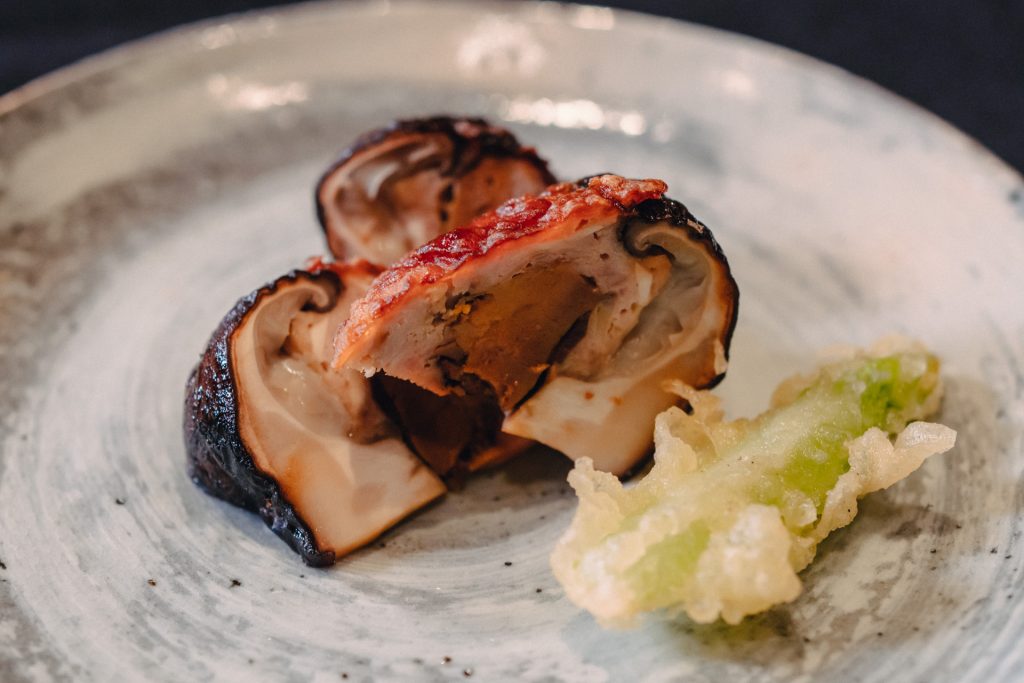
This surprises guests, who ask, “Is it foie gras?” It’s the liver of an Amakusa Daio chicken, which has been marinated in sake lees and then stuffed into log-grown shiitake along with minced chicken meat. It is finished in front of the guests by grilling it over charcoal.
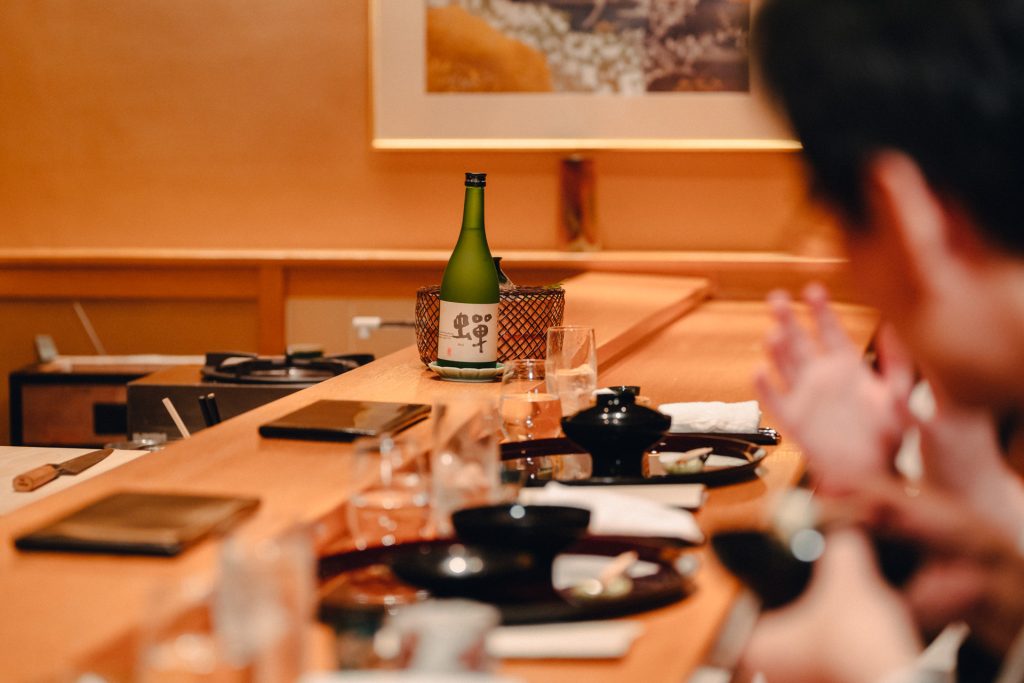
The meal progresses at the guests’ pace. The tableware essential to this “delicious” performance was made at the Hagimigama kiln in Matsubasecho.
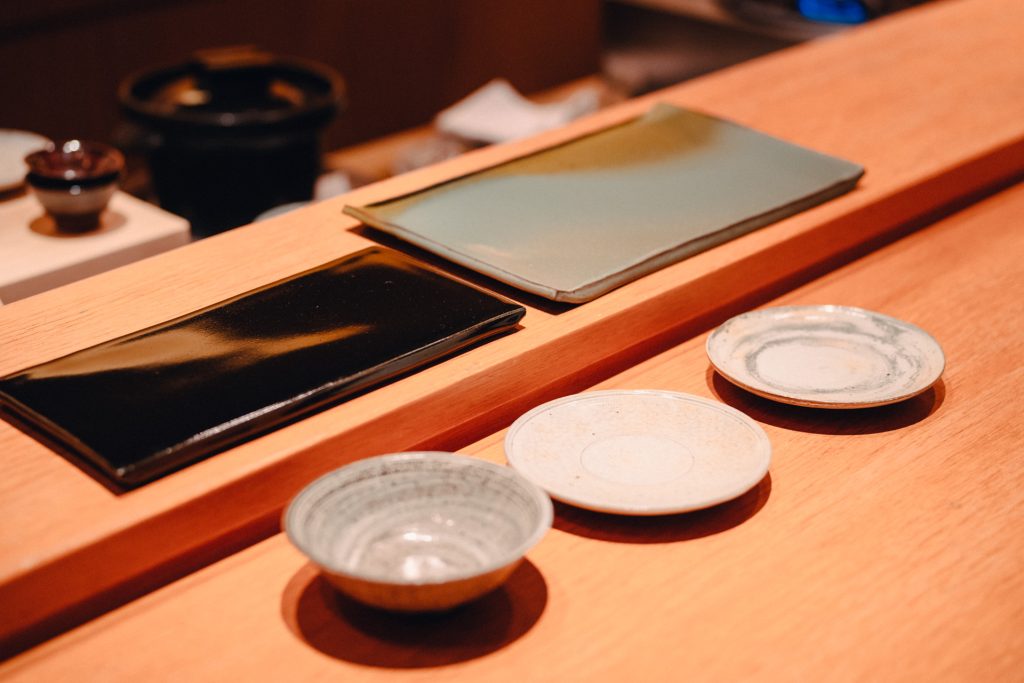
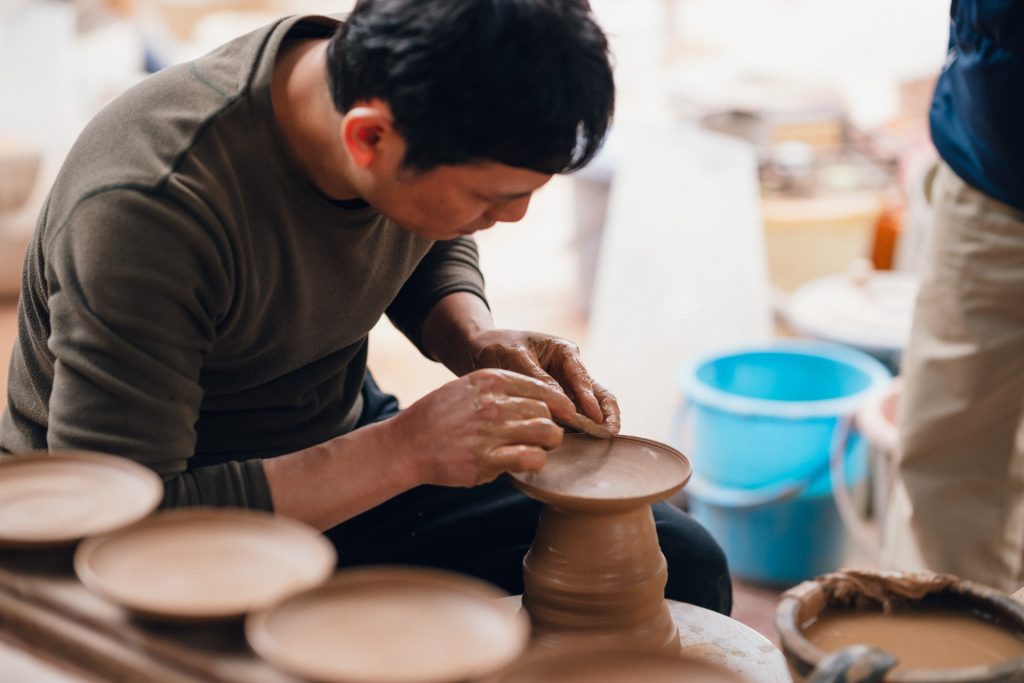
At Hagimigama kiln, Shimpei Ido makes pottery using clay from Uki City, where the kiln is located. The clay produces a unique color known as Yakihassun bronze. Each item has a different texture, which makes it perfect for enjoying an encounter with cuisine and tableware.
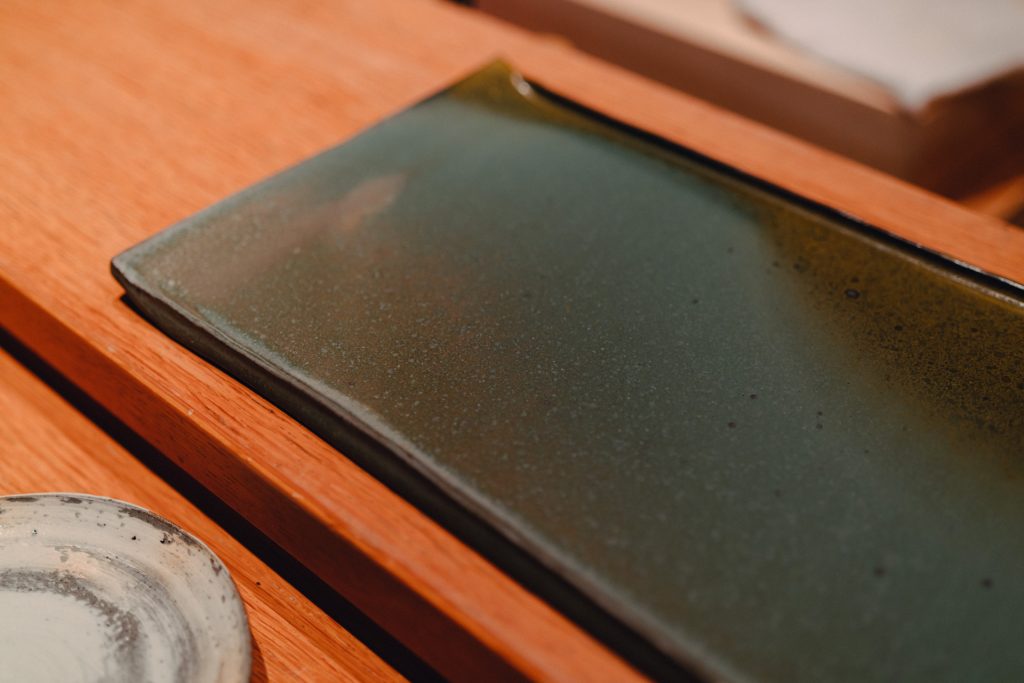
The sushi plates look like black lacquer trays. Both ends are slanted, which makes guests feel that something elegant will happen. Mr. Ido is known for paying attention not only to beauty and appearance but also to the ease of use.
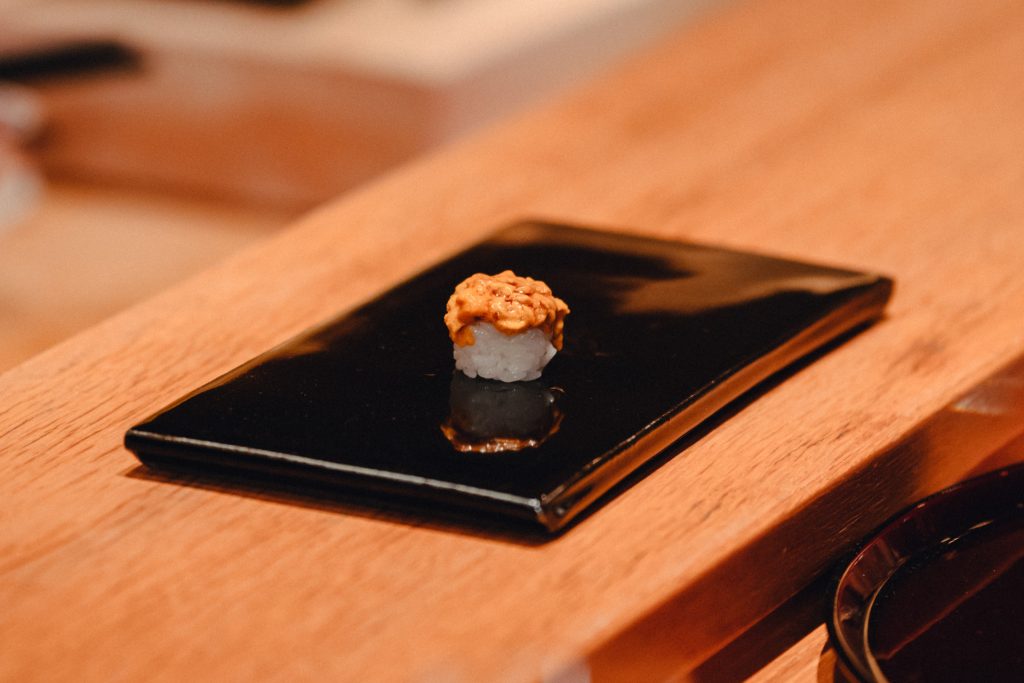
Mealtime is coming to an end. The final chapter is “Fruit.” “When I created the menu, I was quite worried because rice is used in sushi, and I really wanted to have rice at the end of the meal,” Chef Nakajima says.
The result was Yamato Aigamo rice cooked with sardine minnows and lotus root and served with spiny lobster soup.
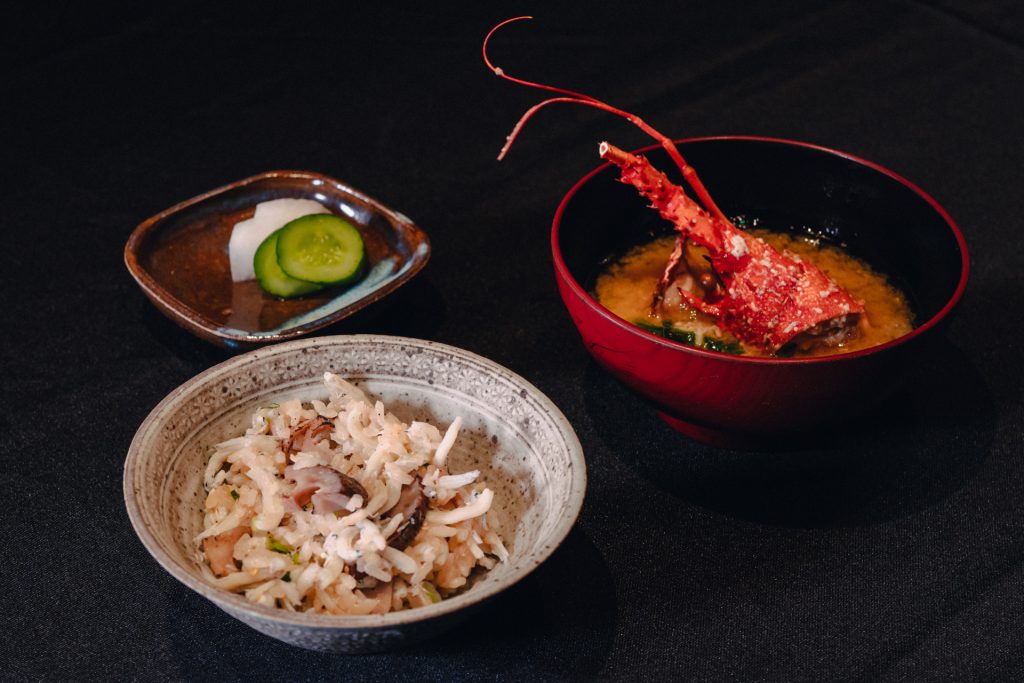
The rice is Aigamo rice from Shogo Hatta’s Maruhachi Farm. He is the head of Only in Yamato. He continues the tradition of growing Aigamo rice, which is a type of rice in which the flavor increases as it is chewed, so that it needs no accompaniments.
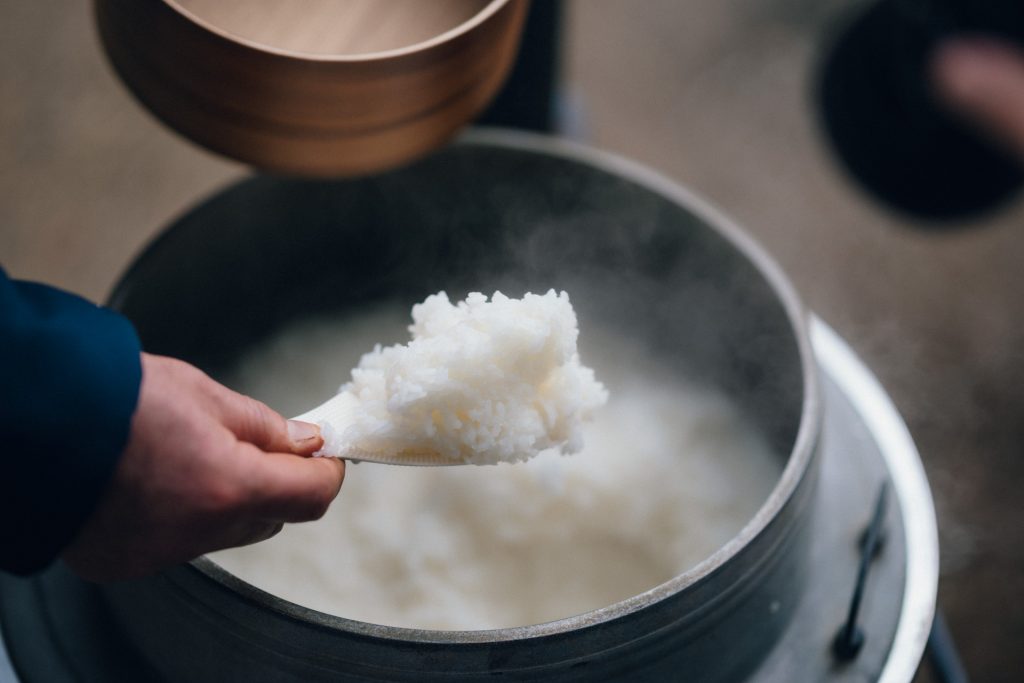
Of course, the miso in the spiny lobster soup is from Kumamoto. This miso was fermented naturally by Shogo Foods in Uki City using only locally sourced ingredients, like soybeans grown in Aso and barley from Kikuchi.
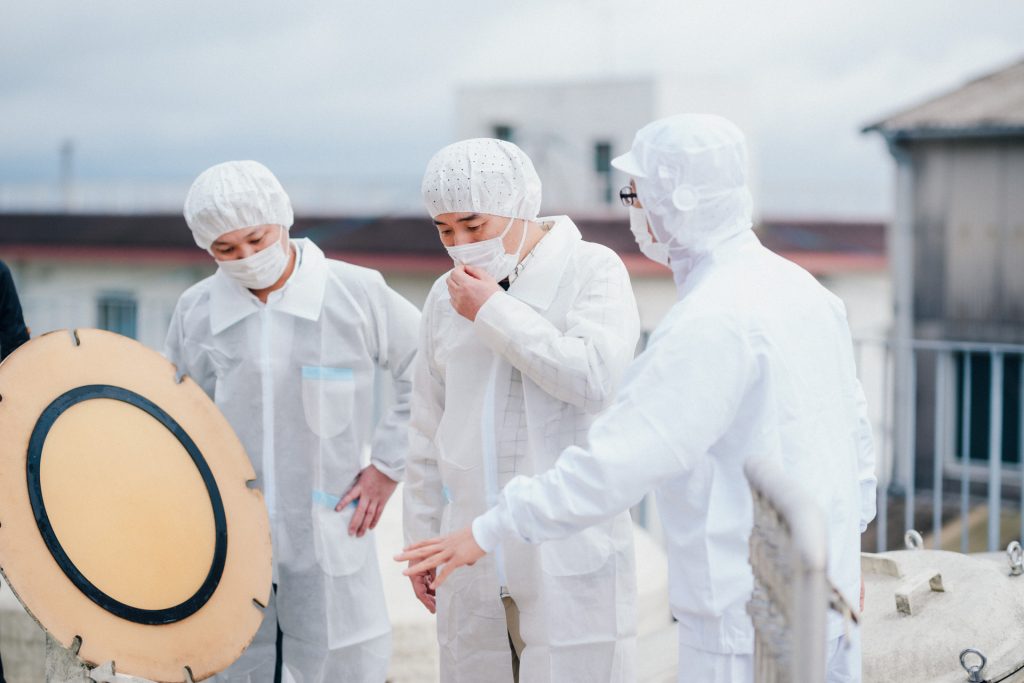
One can tell the difference in the taste of the strongly fermented miso and soy sauce. In Japanese cuisine, seasonings are carefully selected so that the food will not be overly seasoned and the taste of the ingredients will come out. That is why seasonings that taste good and are gentle on one’s system are best suited to this Premium Menu.
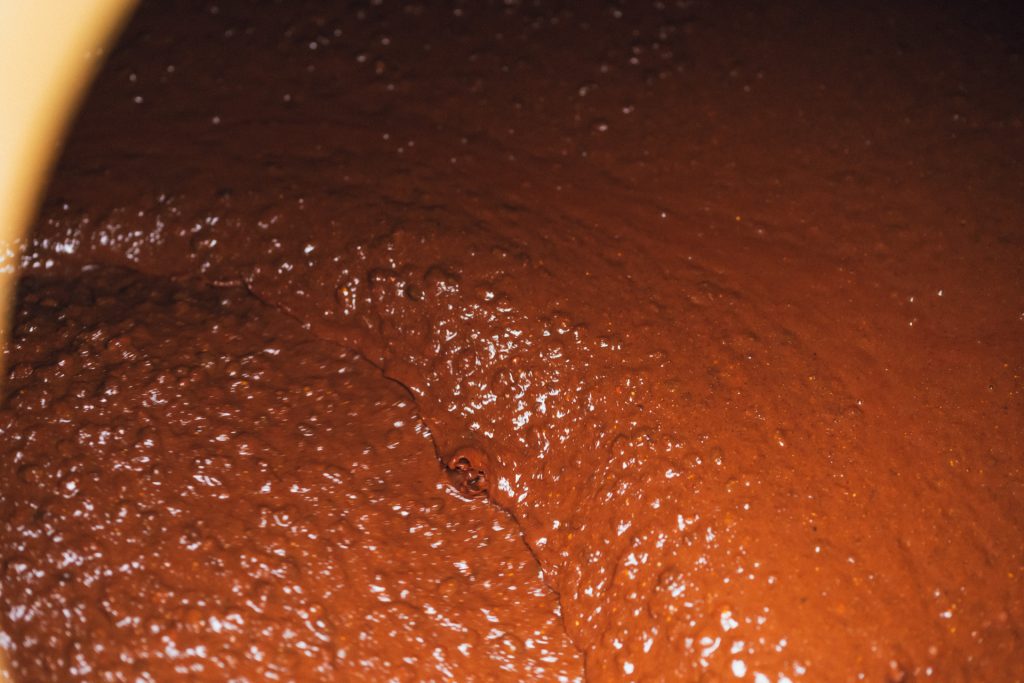
A soup made from carefully selected miso and spiny lobster broth. It has to be good!
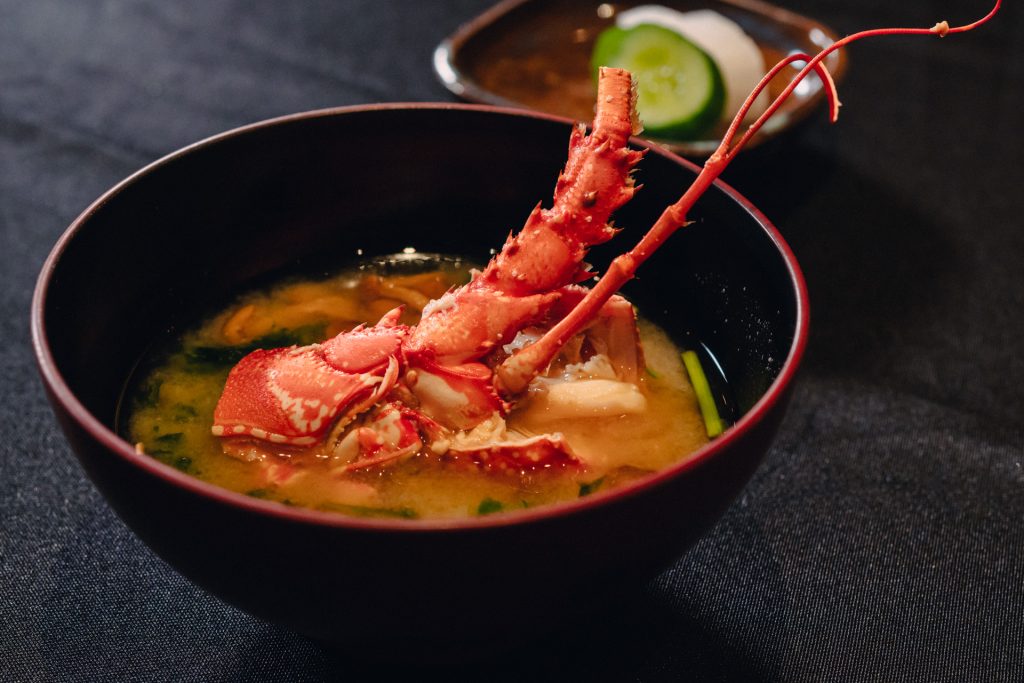
The last visitor is Yoshihaku Nakahata from Nakahata Farm, who also belongs to Only in Yamato.
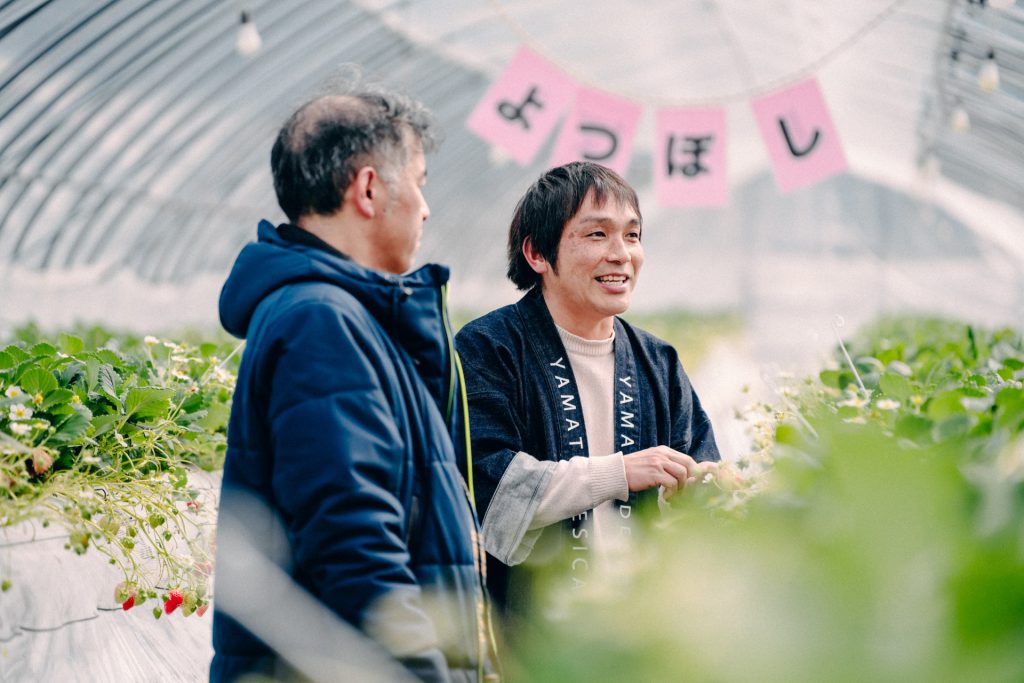
He grows strawberries, which are suited to the cool mountainous terrain, which has limited sunshine. After overcoming many obstacles, he now uses remote management and other IT to successfully cultivate and ship sweet, scrumptious strawberries grown in limited sunlight.
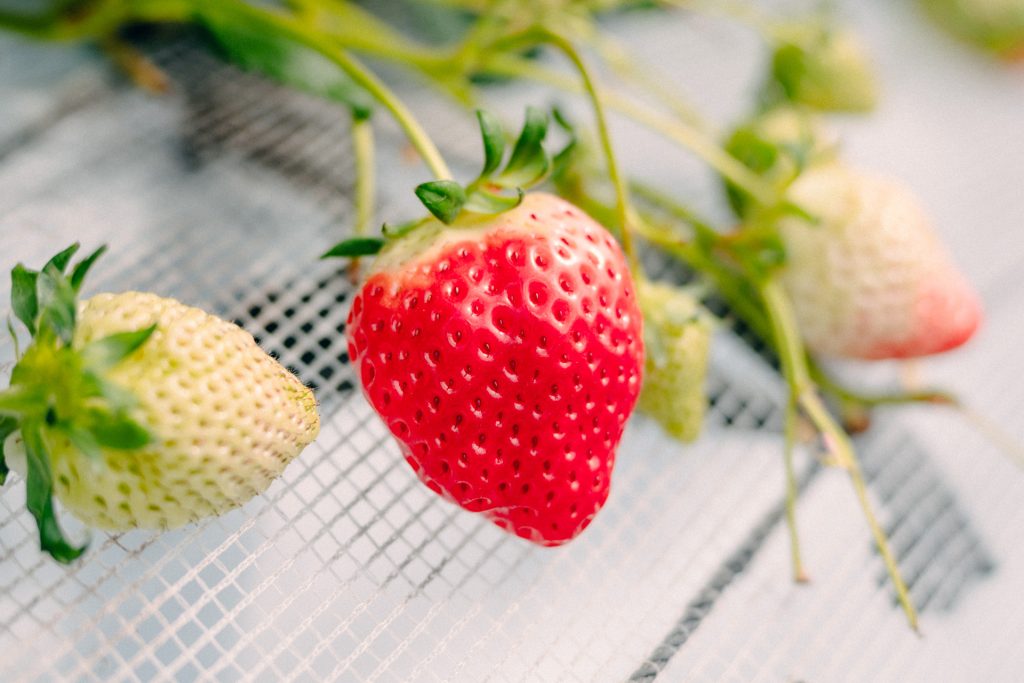
The Sagahonoka strawberry is used in monaka sweets, and Yotsuboshi strawberries are used in strawberry milk.
The monaka combines the fragrance of charcoal-roasted monaka with the sweet-sour taste of azuki beans and strawberries.
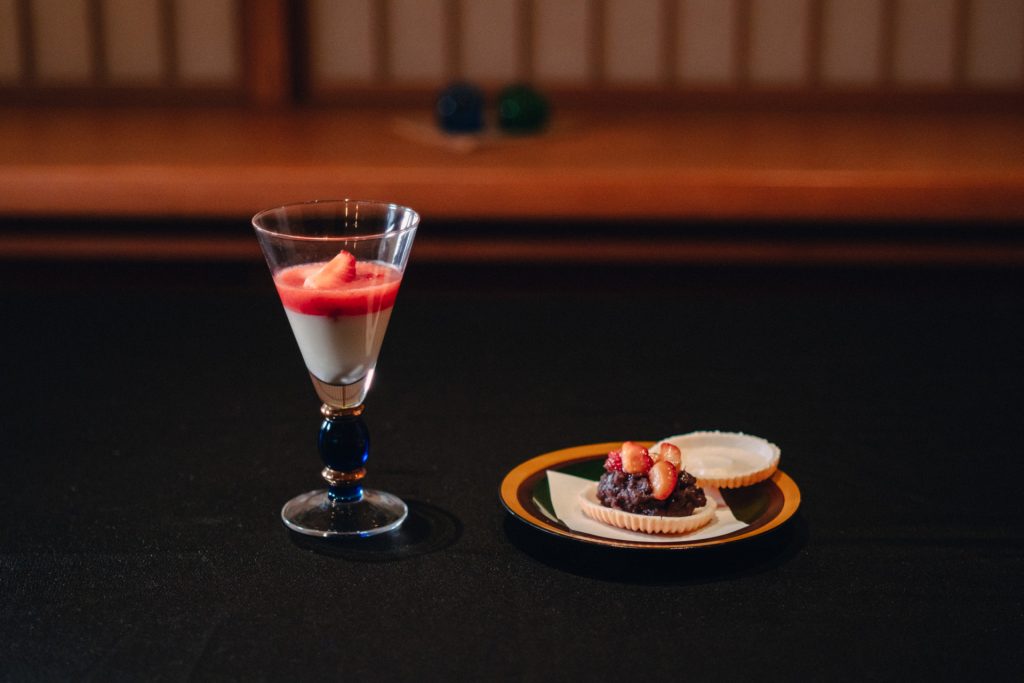
Then, the finale is strawberry milk, which Chef Nakajima says he created from a nostalgic scene that he recalled when he visited the producer. He made it because it reminded him about the strawberry milk he had when he was a child.
We hope you enjoy this special hospitality of the Tsumugu Premium Menu, which intertwines the bounties of the hills, sea, and land, the bounties of Kumamoto, and spirit of the people we encountered.
Restaurant information
Address:Hotel Nikko Kumamoto, 7th fl., 2-1, Kamidoricho, Chuo—ku, Kumamoto City, Kumamoto Prefecture
TEL:096-211-1673 *Reserve by 14:00 three days in advance (in Japanese)
Business hours:17:30-21:30 (last order, 19:30) *Closed Wed.
Website:https://nikko-kumamoto.co.jp/restaurant/tachibana/menu/7/
Reservations for the Premium Menu
Each restaurant has different ingredients in its Premium Menu, so diners may enjoy Kumamoto’s seasonal dishes. Please directly contact the restaurant for details.
“Tsumugu” Premium Kumamoto Dinner
Price:30,000 per person *Limited to 6 meals per day
Tel.: 096-211-1673 *Reserve by 14:00 three days in advance (in Japanese)
 Facebookでシェア
Facebookでシェア Twitterでシェア
Twitterでシェア LINEでシェア
LINEでシェア